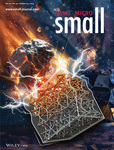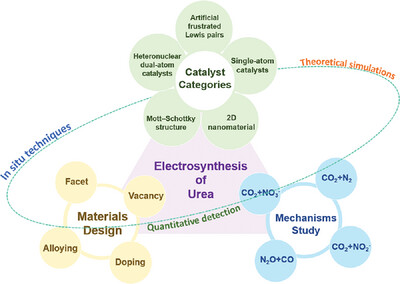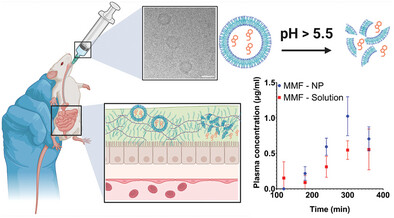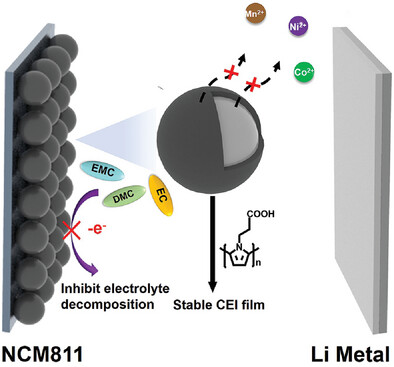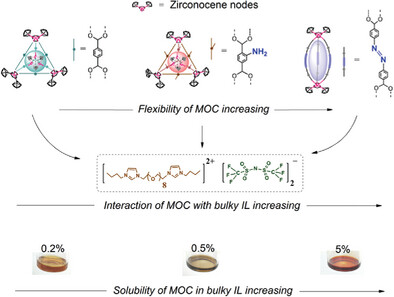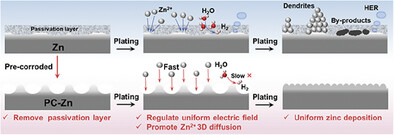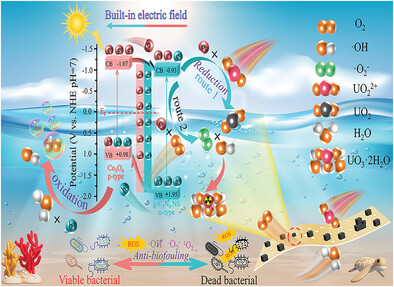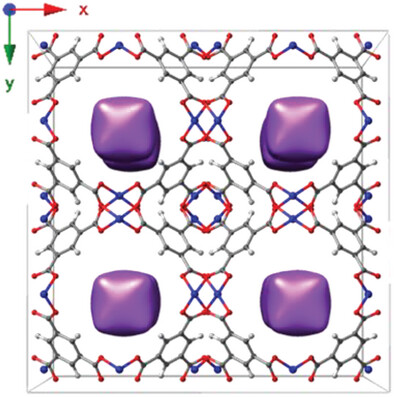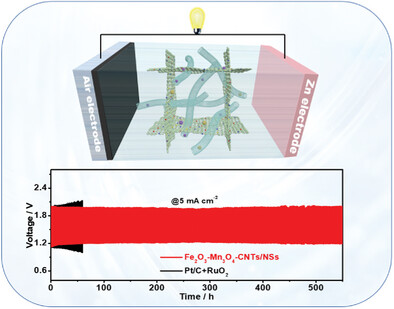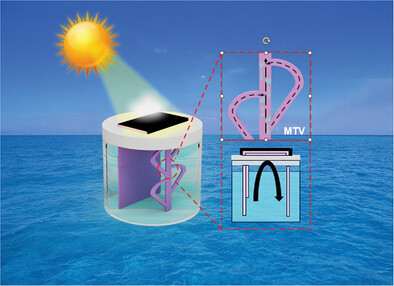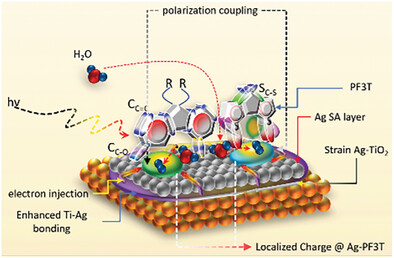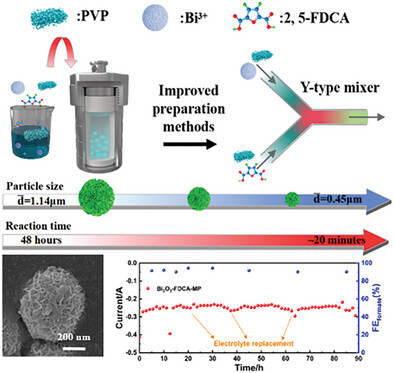Journal list menu
Export Citations
Download PDFs
Cover Picture
Adjustable Ultra-Light Mechanical Negative Poisson's Ratio Metamaterials with Multi-Level Dynamic Crushing Effects (Small 43/2024)
- First Published: 23 October 2024
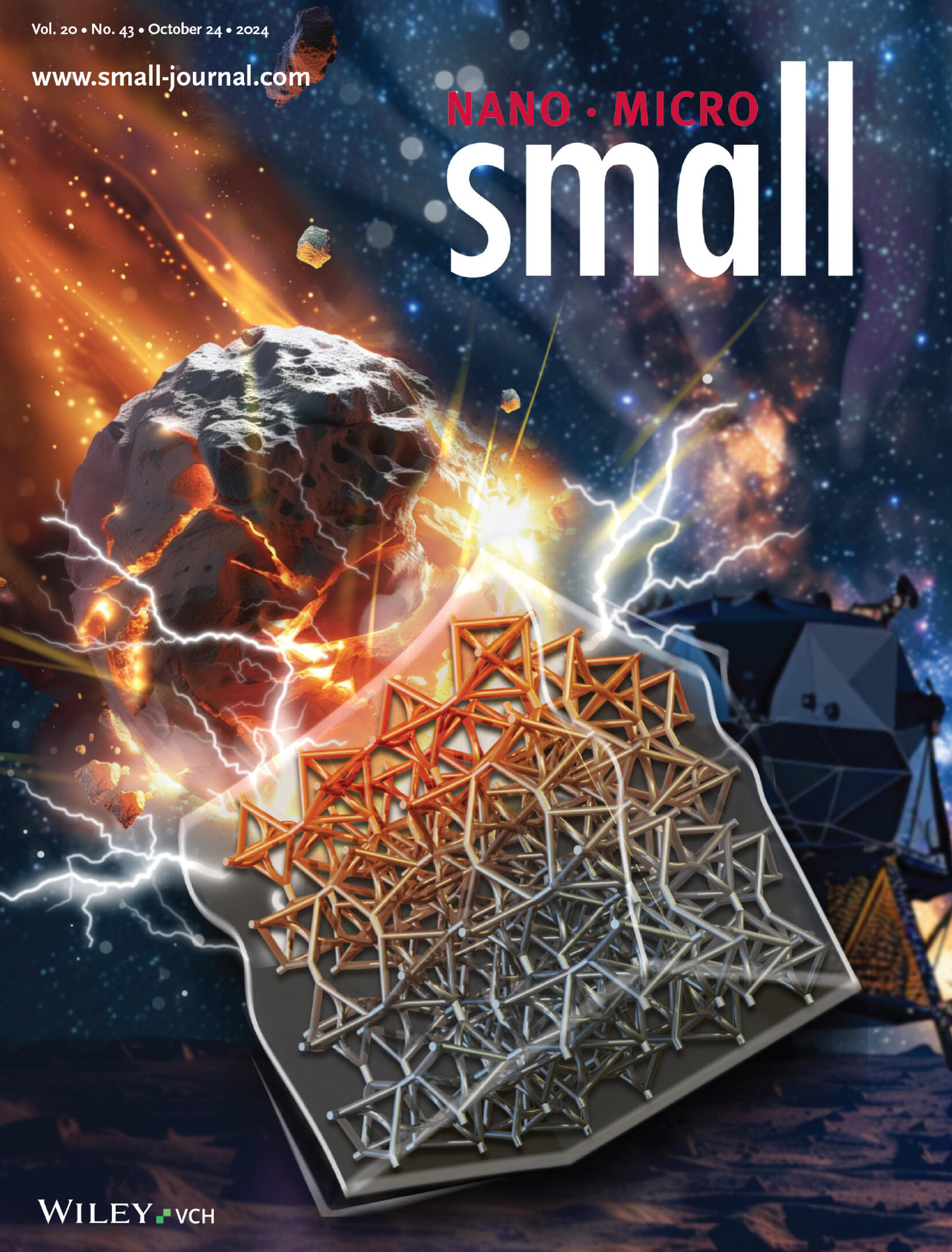
Mechanical Metamaterials
In article number 2403082, Xin Wang, Zhen Li, Pengfei Wang, and co-workers designed mechanical metamaterials with multi-level dynamic crushing effects (MM-MLs) through coordinate transformation and mirror arrays. MM-MLs exhibit significant parameter controllability and are capable of achieving various platform stress regions, ranges of Poisson's ratios, and energy absorption requirements, tailored to the specific application scenario. The proposed design scheme can offer insights into adaptive crushing protection requirements.
Inside Front Cover
Tailored Polymersomes for Enhanced Oral Drug Delivery: pH-Sensitive Systems for Intestinal Delivery of Immunosuppressants (Small 43/2024)
- First Published: 23 October 2024
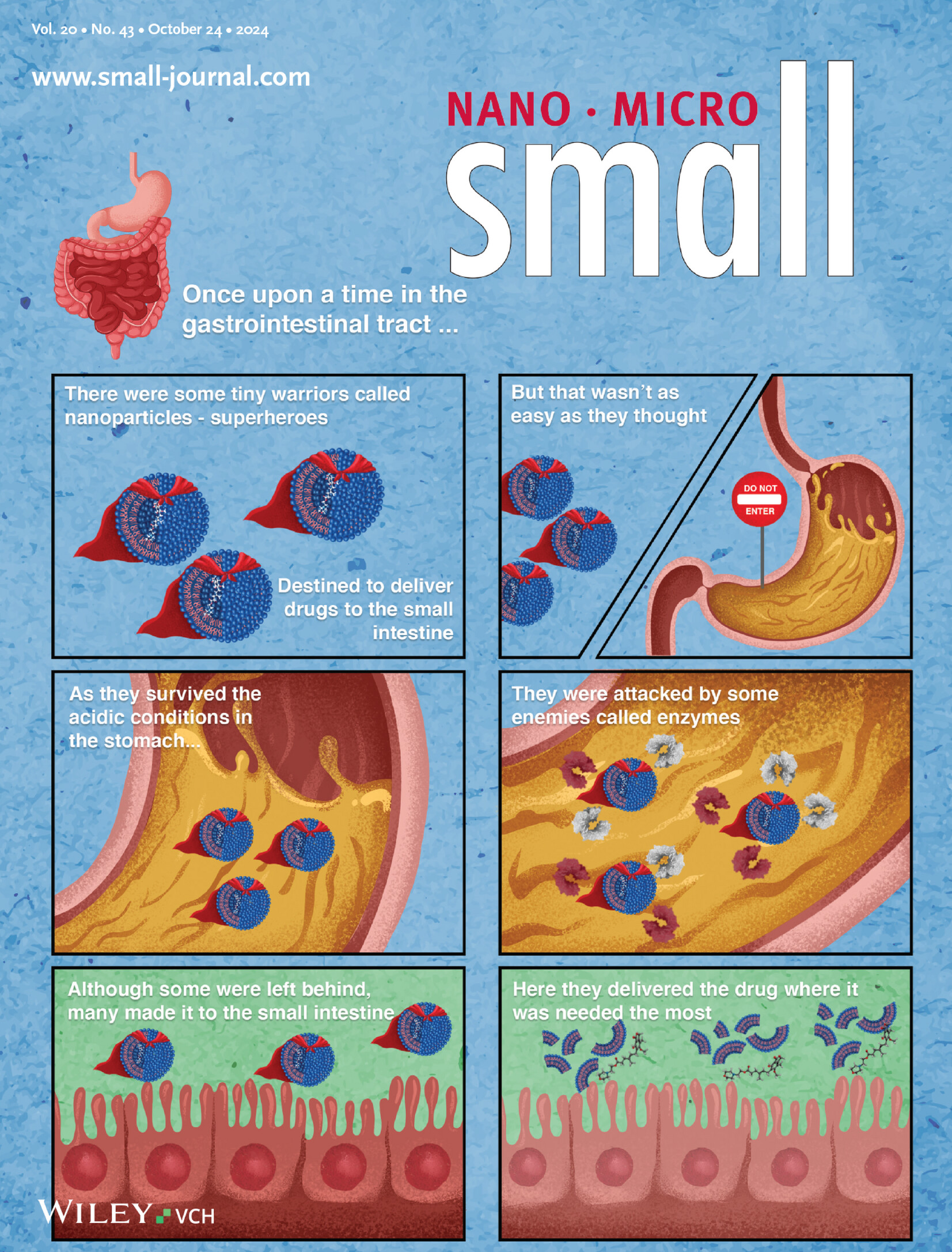
Oral Drug Delivery
In article number 2403640, Matteo Tollemeto and co-workers aimed to design a nanoparticle drug delivery system that maintains drug solubility while delaying absorption from the stomach to the intestine. In vivo rat studies of pH-responsive polymersomes showed reduced stomach absorption and enhanced intestinal absorption, offering a promising treatment for inflammatory bowel disease.
Inside Back Cover
Enhanced Thermoelectric Performance of Nanostructured 2D Tin Telluride (Small 43/2024)
- First Published: 23 October 2024
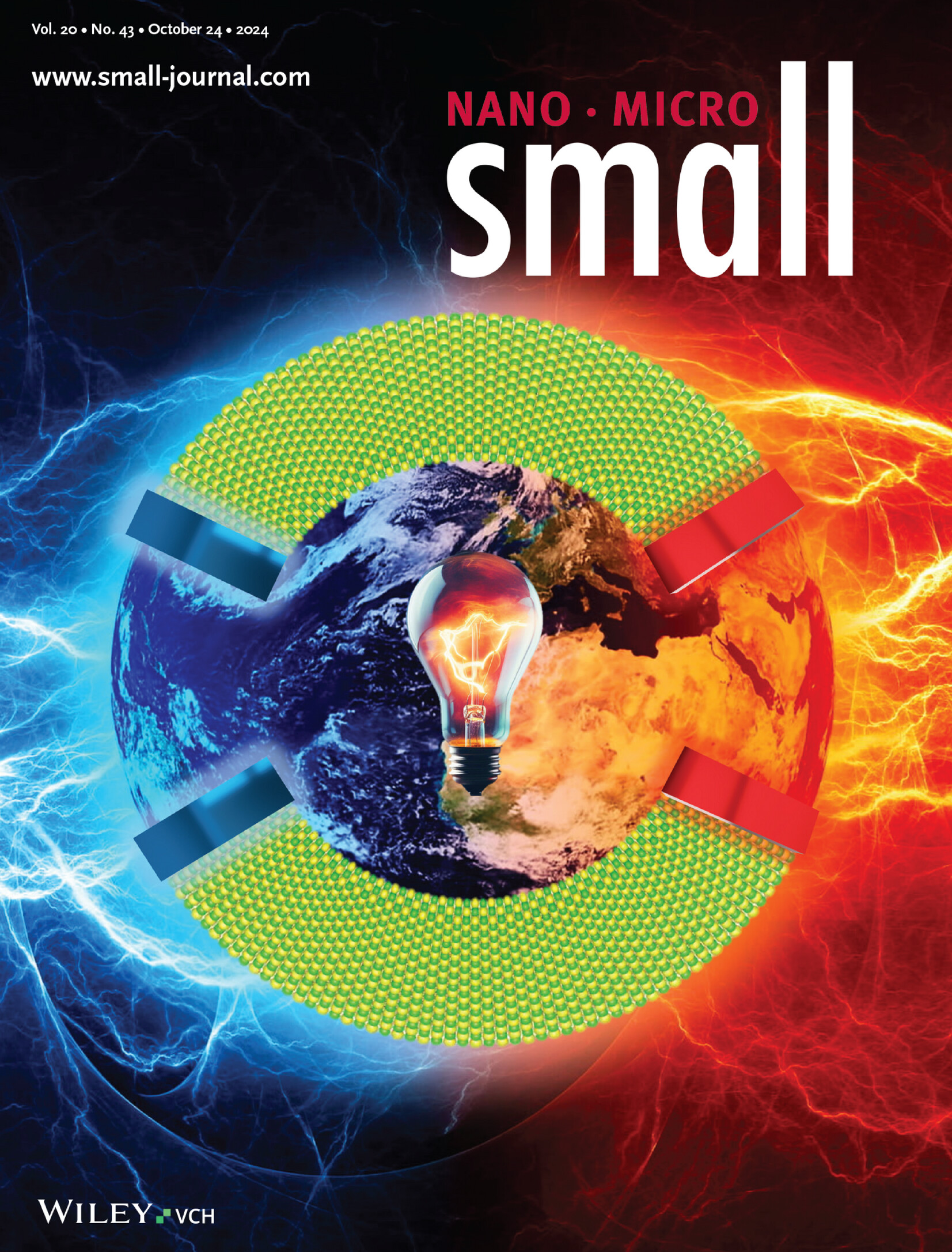
Thermoelectric 2D Materials
The atomically thin 2D SnTe can be utilized to harvest waste heat around us. The flexibility of the 2D SnTe can be effective to coat/paint to different topology and shows multifold enhancement in thermoelectric properties. More in article number 2403728, Punathil Raman Sreeram, Chandra Sekhar Tiwary, and co-workers.
Back Cover
Lysosome-Targeting Bacterial Outer Membrane Vesicles for Tumor Specific Degradation of PD-L1 (Small 43/2024)
- First Published: 23 October 2024
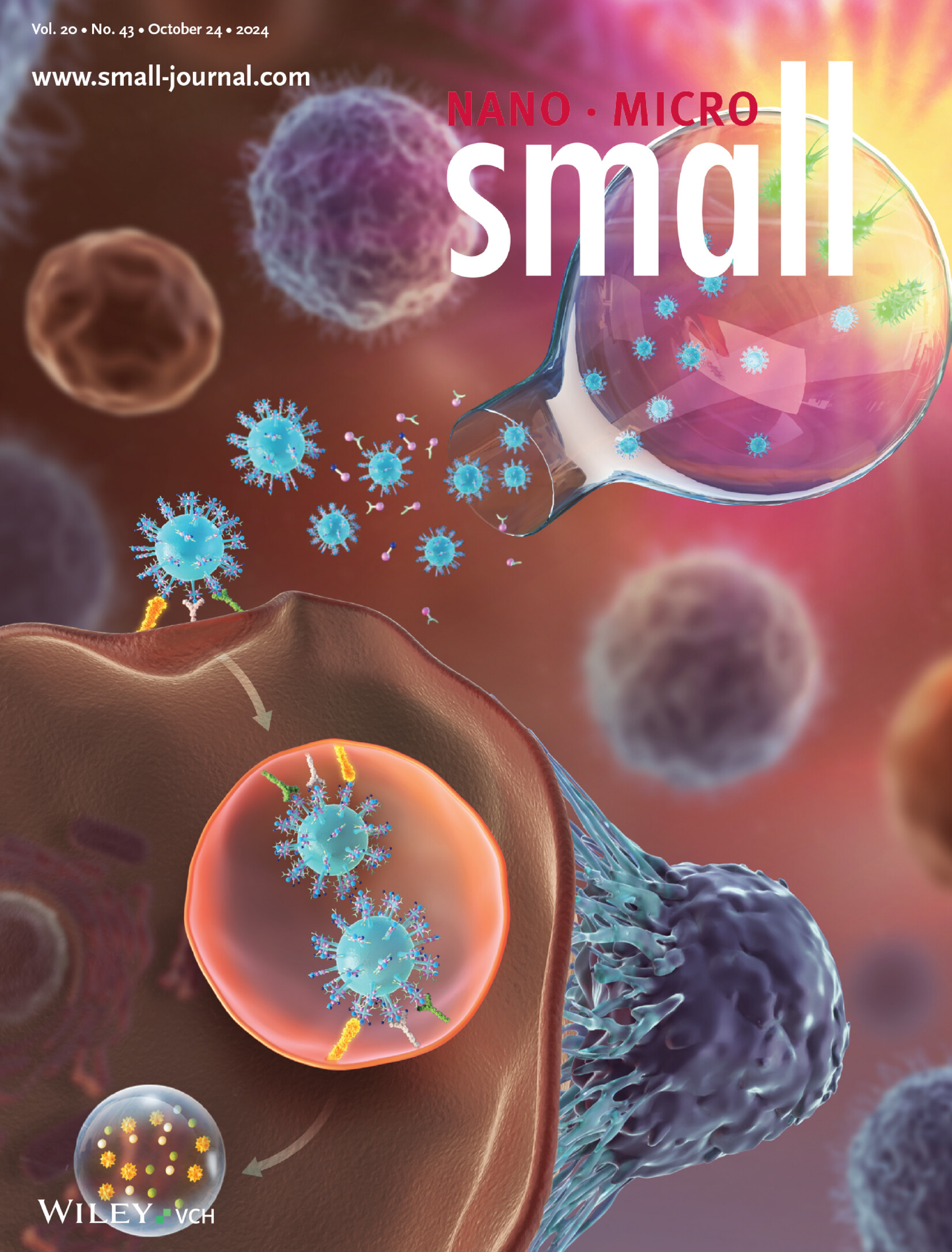
Tumor Therapy
In article number 2400770, Fan Lu, Guodong Yang, Gang Ji, and co-workers developed an outer membrane vesicle (OMV)-based nanosystem to unleash the anti-tumor immunity via targeted degradation of PDL1. The tumor homing OMVs derived from engineered bacteria are empowered to trigger PDL1 degradation after simply absorbing dual ligands for lysosome-targeting receptor and PDL1. The proposed bacteria-driven PDL1 degrader is highly manufacturable and scalable, shedding new light on immune checkpoint blockade therapy.
Masthead
Review
A Review: Surface Engineering of Lipid-Based Drug Delivery Systems
- First Published: 14 July 2024
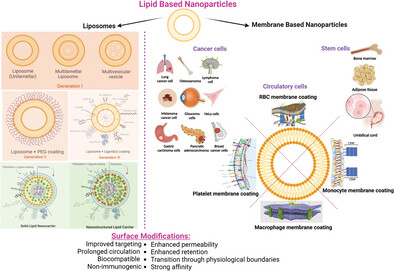
Lipid-based nanoparticles are effective drug-delivery systems primarily consisting of liposomes and membrane-based nanoparticles. The potential of liposomes can be improved through surface modification. Liposomes can be transformed into biomimetic nanoparticles by coating them with various cell membranes originating from immune cells, circulatory cells, or stem cells. Surface engineering enhances nanoparticle circulation, targetability, and biocompatibility without causing immunogenicity.
Delivery of mRNA Using Biomimetic Vectors: Progress and Challenges
- First Published: 14 July 2024
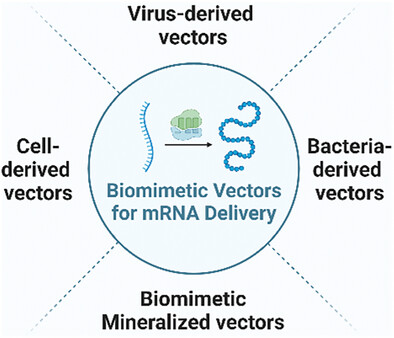
The review summarizes recently developed biomimetic vectors for messenger RNA (mRNA) delivery, highlighting their advantages such as high biocompatibility, tissue-specific targeting ability, and efficient delivery mechanisms. It discusses four types of vectors, including viral, bacterial, cell-derived vectors, and biomimetic mineralized nanoparticles. Furthermore, the review addresses the challenges and prospects of these vectors, presenting advancements in mRNA-based therapies within the biomedical field.
High-Performance Bifunctional Electrocatalysts for Flexible and Rechargeable Zn–Air Batteries: Recent Advances
- First Published: 02 July 2024

It is necessary and challenging to explore high-performance bifunctional electrocatalysts. In flexible rechargeable Zn–air batteries (FZABs), the bifunctional electrocatalysts are widely utilized in the form of powder-based flexible air cathodes and flexible self-supporting air cathodes. Various nanostructures, such as interfaces, frameworks, core–shell structures, and array structures are designed to contribute to the realization of high performance of FZABs.
Non-Fullerene Organic Electron Transport Materials toward Stable and Efficient Inverted Perovskite Photovoltaics
- First Published: 26 June 2024
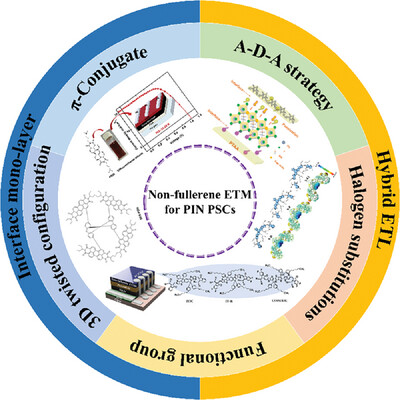
Non-fullerene n-type organic semiconductors play a critical role as alternatives to fullerene electron transport materials (ETMs) in inverted perovskite solar cells (PSCs). In this review, non-fullerene ETMs based on the molecular functionalization strategy are comprehensively summarized and their device efficiency and stability are thoroughly discussed. More efficient and stable inverted PSCs are expected with the innovation of new non-fullerene ETMs.
Electrocatalytic Synthesis of Urea: An In-depth Investigation from Material Modification to Mechanism Analysis
- First Published: 27 June 2024
High-Entropy Materials in Electrocatalysis: Understanding, Design, and Development
- First Published: 27 June 2024
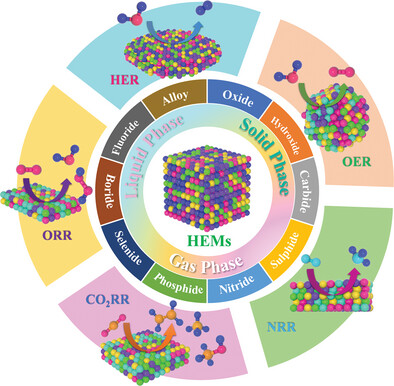
High entropy materials are widely used in electrocatalysis due to the synergistic effect of many components. This review provides a detailed overview of the properties and types, synthesis strategies, and applications in electrocatalysis of high-entropy materials. Finally, the progress, challenges, and opportunities of high entropy materials in electrocatalysis are summarized.
Recent Research on Iridium-Based Electrocatalysts for Acidic Oxygen Evolution Reaction from the Origin of Reaction Mechanism
- First Published: 28 June 2024
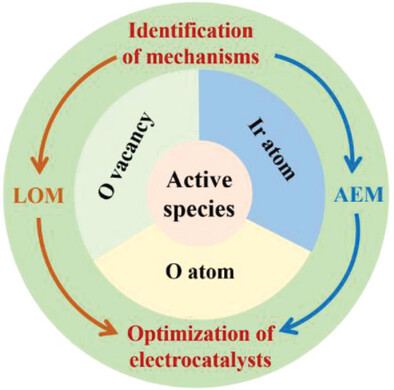
Conventional and unconventional acidic OER mechanisms such as AEM, dual-site mechanism, and LOM are fully analyzed, and relevant Ir-based electrocatalyst optimization strategies are summarized and classified from the perspective of these reaction mechanisms. Further, the active species of Ir-based electrocatalysts in acidic OER are discussed and summarized. Finally, the future research direction and prospect of Ir-based electrocatalysts are presented.
A Current Development of Energy Harvesting Systems for Energy-Independent Bioimplantable Biosensors
- First Published: 10 July 2024
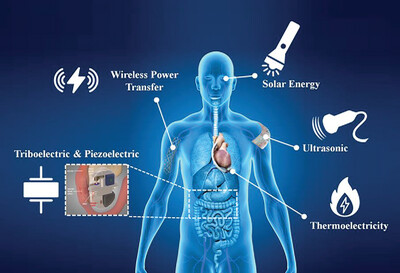
Energy harvesting systems represent a game-changing innovation in biosensor powering, providing long-term, off-grid options for continuous, autonomous operation. This study examines diverse harvesting techniques—optical, mechanical, thermal, and wireless—and emphasizes their vital role in improving biosensor efficiency and application. These breakthroughs have the potential to change industries such as medicine, environmental surveillance, and biosignal analysis, demonstrating considerable progress in decreasing environmental impact and increasing the reach of biosensor technology.
Recent Progress in MOF-Aerogel Fabrication and Applications
- First Published: 08 July 2024
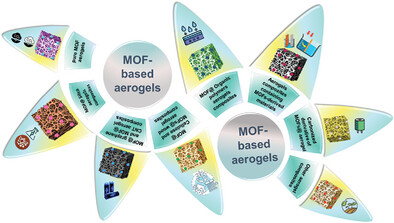
Recent progress in the metal-organic framework (MOF)-based aerogels materials, especially the development of hybrid systems incorporating graphene, carbon nanotube, silica, and cellulose @ MOF aerogels, their functional properties, and applications in adsorption, catalysis, and energy storage are reviewed and prospects have been illustrated.
Advanced Nanocarbons Toward two-Electron Oxygen Electrode Reactions for H2O2 Production and Integrated Energy Conversion
- First Published: 05 July 2024
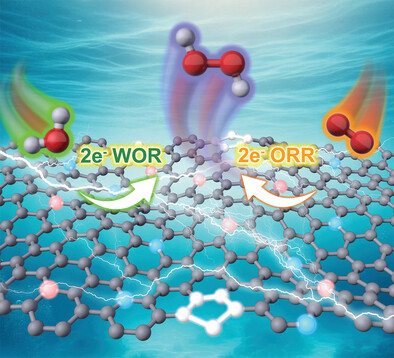
Recent cutting-edge developments of carbon-based metal-free electrochemical catalysts for hydrogen peroxide production via both two electron oxygen reduction reaction and water oxidation reaction are reviewed, with a focus on fundamental concepts, recent strategies for catalyst fabrication, atomic site activation and performance evaluation, reactor/integrated system design, along with current controversial issues and prospects.
Frontispiece
High-Energy Polynitrogen N10 Stabilized on Multi-Walled Carbon Nanotubes (Small 43/2024)
- First Published: 23 October 2024
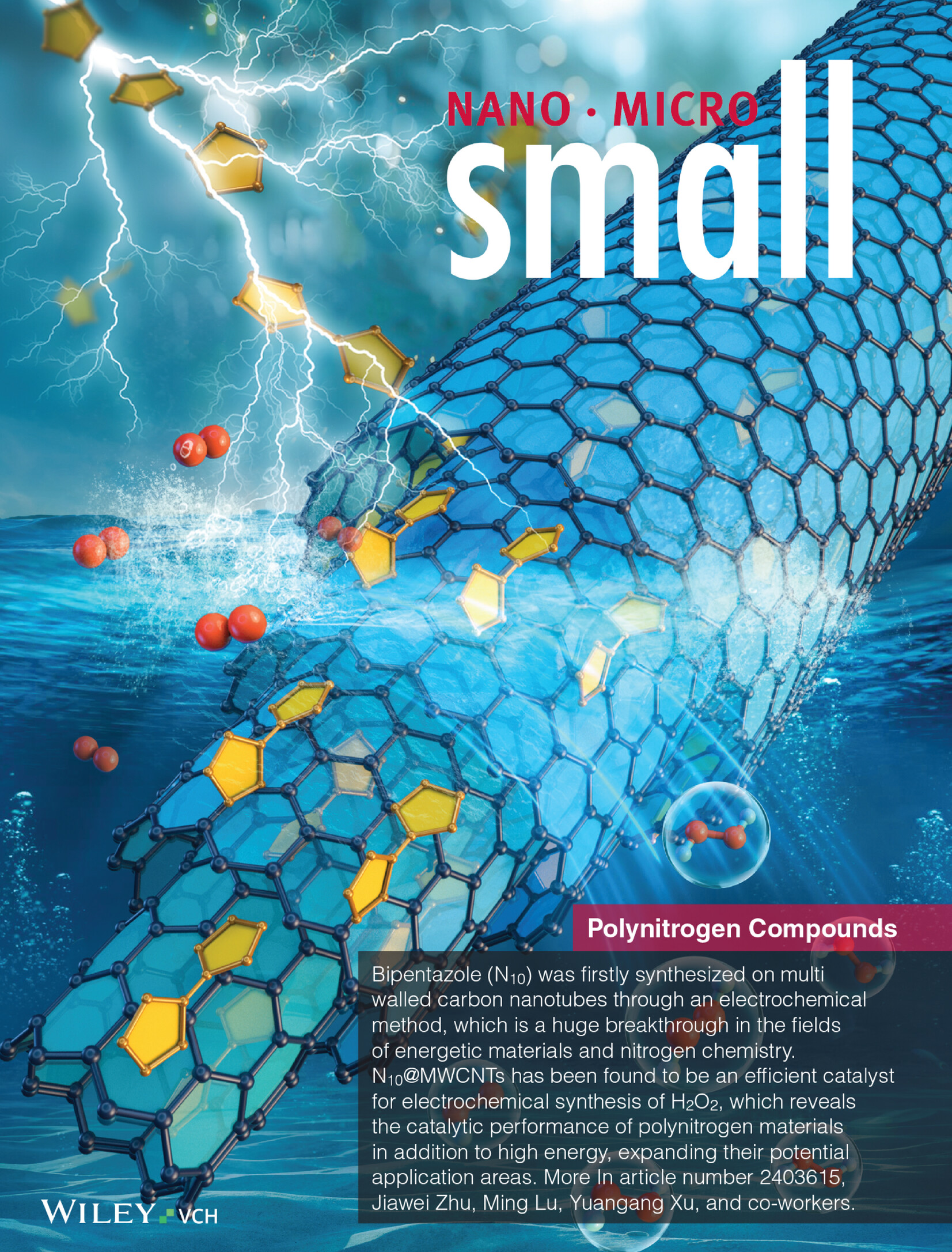
Polynitrogen Compounds
Bipentazole (N10) was firstly synthesized on multi walled carbon nanotubes through an electrochemical method, which is a huge breakthrough in the fields of energetic materials and nitrogen chemistry. N10@MWCNTs has been found to be an efficient catalyst for electrochemical synthesis of H2O2, which reveals the catalytic performance of polynitrogen materials in addition to high energy, expanding their potential application areas. More In article number 2403615, Jiawei Zhu, Ming Lu, Yuangang Xu, and co-workers.
Research Article
High-Energy Polynitrogen N10 Stabilized on Multi-Walled Carbon Nanotubes
- First Published: 03 August 2024
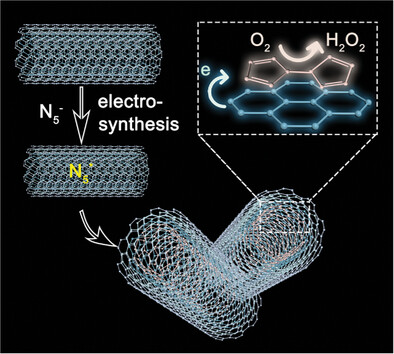
Aromatic and structurally symmetric bipentazole (N10) is successfully synthesized via electrochemical synthesis using highly conductive multi-walled carbon nanotubes (MWCNTs) as the substrate and sodium pentazolate hydrate ([Na(H2O)(N5)]·2H2O) as the raw material. And the N10 stabilized on MWCNTs has excellent 2-electron oxygen reduction properties.
Frontispiece
Aggregation-Induced Emissive Feringa-Type Motor: Toward the Dual-Functional Motor in a Single Molecular Aggregation System (Small 43/2024)
- First Published: 23 October 2024
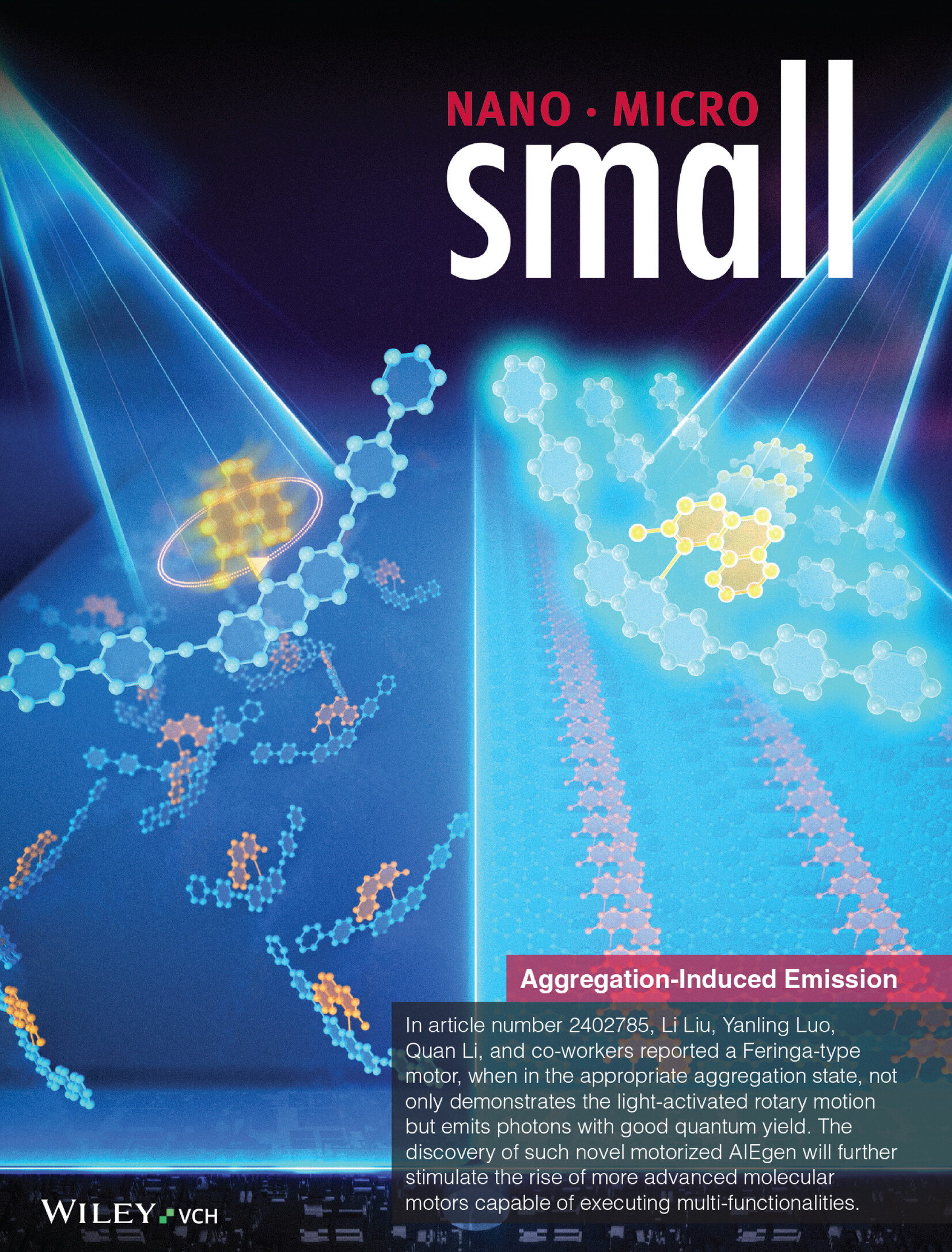
Aggregation-Induced Emission
In article number 2402785, Li Liu, Yanling Luo, Quan Li, and co-workers reported a Feringa-type motor, when in the appropriate aggregation state, not only demonstrates the light-activated rotary motion but emits photons with good quantum yield. The discovery of such novel motorized AIEgen will further stimulate the rise of more advanced molecular motors capable of executing multi-functionalities.
Research Article
Aggregation-Induced Emissive Feringa-Type Motor: Toward the Dual-Functional Motor in a Single Molecular Aggregation System
- First Published: 07 August 2024
Frontispiece
Micro/Nano Hierarchical Crater-Like Structure Surface With Mechanical Durability and Low-Adhesion for Anti-Icing/Deicing (Small 43/2024)
- First Published: 23 October 2024
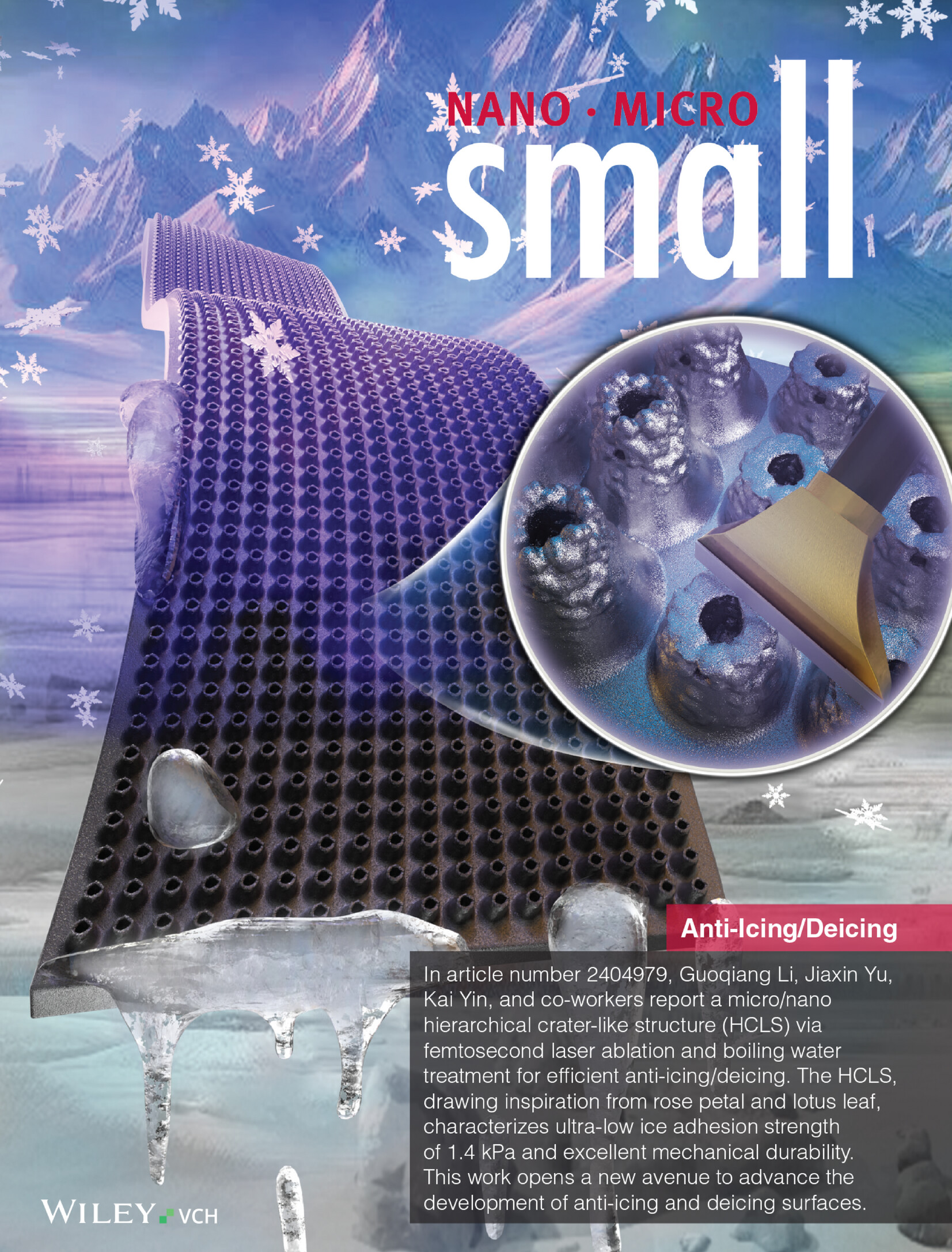
Anti-Icing/Deicing
In article number 2404979, Guoqiang Li, Jiaxin Yu, Kai Yin, and co-workers report a micro/nano hierarchical crater-like structure (HCLS) via femtosecond laser ablation and boiling water treatment for efficient anti-icing/deicing. The HCLS, drawing inspiration from rose petal and lotus leaf, characterizes ultra-low ice adhesion strength of 1.4 kPa and excellent mechanical durability. This work opens a new avenue to advance the development of anti-icing and deicing surfaces.
Research Article
Micro/Nano Hierarchical Crater-Like Structure Surface With Mechanical Durability and Low-Adhesion for Anti-Icing/Deicing
- First Published: 23 August 2024
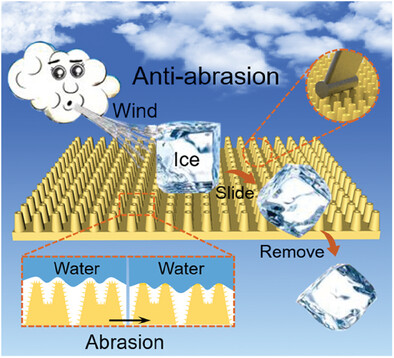
The micro/nano hierarchical crater-like structure (HCLS), inspired by rose petal and lotus leaf, is fabricated by femtosecond laser ablation and boiling water treatment and can be used in efficient anti-icing/deicing for its ultra-low ice adhesion strength of 1.4 kPa and exceptional mechanical durability endowed by the unique double bionic structure.
Adjustable Ultra-Light Mechanical Negative Poisson's Ratio Metamaterials with Multi-Level Dynamic Crushing Effects
- First Published: 14 July 2024
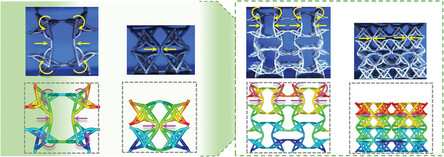
Mechanical metamaterials with multi-level dynamic crushing effects (MM-MLs) are designed in this study through coordinate transformation and mirror arrays. MM-ML has significant parameter controllability and can achieve different platform stress regions, ranges of Poisson's ratios, and energy absorption requirements according to the application scenario. The design scheme can provide ideas for adaptive crushing protection requirements.
Tailored Polymersomes for Enhanced Oral Drug Delivery: pH-Sensitive Systems for Intestinal Delivery of Immunosuppressants
- First Published: 04 July 2024
Enhanced Thermoelectric Performance of Nanostructured 2D Tin Telluride
- First Published: 14 June 2024
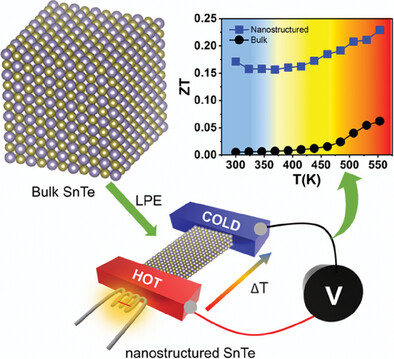
Bulk and 2D SnTe are synthesized using flame melting and liquid phase exfoliation. Nanostructured 2D SnTe shows a Seebeck coefficient of 280 µV K−1, four times higher than bulk SnTe. This is due to increased DOS and bandgap. Enhanced interface scattering reduces thermal conductivity, yielding a high ZT of 0.17, promising wearable self-charging devices.
Lysosome-Targeting Bacterial Outer Membrane Vesicles for Tumor Specific Degradation of PD-L1
- First Published: 27 June 2024
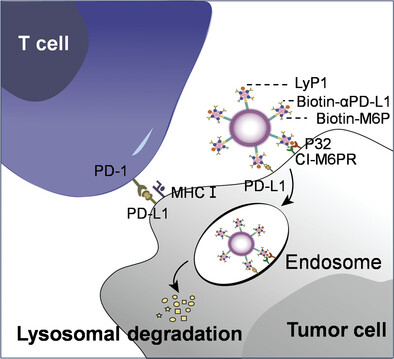
An outer membrane vesicle (OMV)-based PD-L1 blockade strategy for efficient elicitation of anti-tumor immunity is developed. Besides enhanced permeability and retention (EPR) effect, the Lyp-1 further endows the OMV with the capacity to target tumor tissue. Moreover, biotinylated anti-PD-L1 and biotinylated M6P displayed on the surface coordinately direct the PD-L1 to lysosome for degradation.
Improving the Oxygen Evolution Reaction Kinetics in Zn-Air Battery by Iodide Oxidation Reaction
- First Published: 06 July 2024
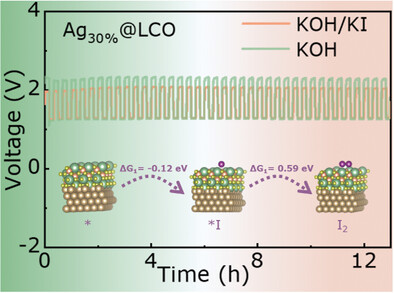
Compared to conventional alkaline electrolytes, the addition of KI electrolyte improves the electrochemical-chemical oxidation reaction of I ions in an alkaline environment, which accelerates charge transfer, reduces reaction overpotential, and inhibits the formation of zinc anode dendrites during the reaction process.
Field-Directed Motion, Cargo Capture, and Closed-Loop Controlled Navigation of Microellipsoids
- First Published: 10 August 2024
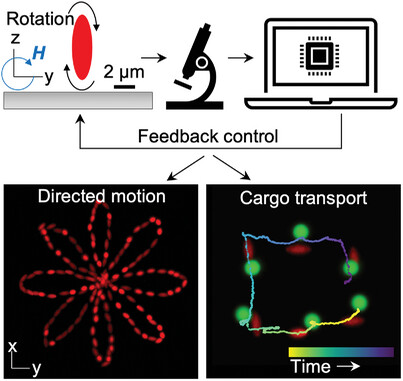
A precise control over the motion of prolate ellipsoid-shaped microrobots is achieved using rotating magnetic fields. The article demonstrates contactless capture, controlled transport, and targeted release of cargo particles and live cells, facilitated solely by hydrodynamic interactions. The close-loop control scheme further enables transport of cargo particles in complex microenvironments, such as a maze, without human intervention.
Oxide Derivatives of Nb2CTx MXene and Their Application as Electron Transport Layers in Perovskite Solar Cells: Unraveling the Oxidation Process and Functionalization
- First Published: 21 August 2024
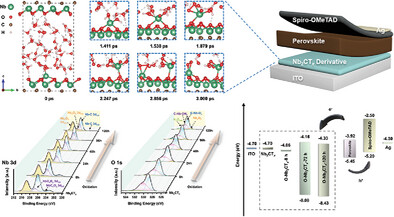
The oxidation process of Nb2CTx MXene is methodically simulated at the atomic level and nanosecond timescales, predicting a transition from metal to semiconductor with 44% C atoms replaced by O atoms in Nb2CTx. By exploiting MXenes to their derivatives, a promising approach to designing ETL for photovoltaic technologies is demonstrated.
Tailoring Stress-Relieved Structure for SnSe Toward High Performance Potassium Ion Batteries
- First Published: 19 June 2024
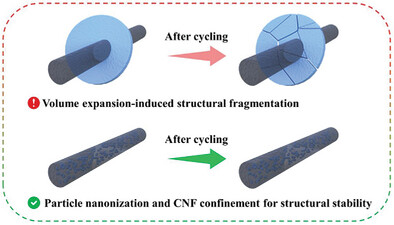
The nanoscale SnSe embedding enhances the thoroughness of electrochemical reactions, while carbon nanofibers buffer internal stress caused by volume expansion. This combined strategy enables SnSe@CNF composite anode to achieve near-theoretical specific capacity of 272 mAh g−1 while maintaining excellent cycling stability.
Minimization of Energy Level Mismatch of PCBM and Surface Passivation for Highly Stable Sn-Based Perovskite Solar Cells by Doping n-Type Polymer
- First Published: 19 June 2024
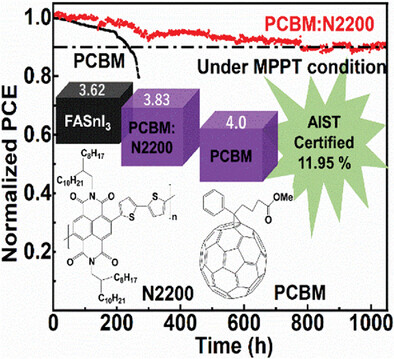
The primary challenges related to Sn-based perovskite solar cells (PSCs) are the inherent susceptibility of Sn2+ oxidation and the significant energy mismatch between the perovskite and electron transport layer (ETL). Doping of n-type polymer (N2200) into PCBM retards the Sn2+ oxidation and reduces the conduction band offset energy at the perovskite/ETL interface. This makes Sn-PSCs highly stable under operational conditions.
In Situ Electrochemical Polymerization of Cathode Electrolyte Interphase Enabling High-Performance Lithium Metal Batteries
- First Published: 17 June 2024
Electrochemical Synthesis of Urea: Co-Reduction of Nitrite and Carbon Dioxide on Binuclear Cobalt Phthalocyanine
- First Published: 20 June 2024
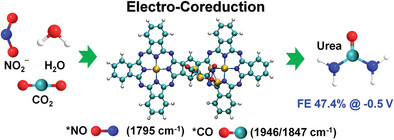
This work demonstrates the importance of designing binuclear molecular catalysts toward urea synthesis. The as-synthesized binuclear cobalt phthalocyanine catalyst shows an ultra-high urea Faradaic efficiency at –0.5 V versus RHE. It is revealed spectroscopically and theoretically that the bridge adsorbed CO acts as active intermediates which can be attacked by nitrite and facilitates C─N coupling.
Architecting Ni3Se4-NiSe2-Co3O4 Triple-Interface Heterostructure on MXene Nanosheets for Boosting Water Splitting by Electronic Modulation and Interface Effects
- First Published: 15 August 2024
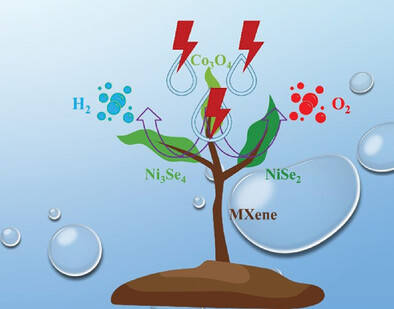
This study designs a novel triple-interface heterostructure comprising Ni3Se4-NiSe2-Co3O4/MXene nanoarrays anchored on Ti3C2Tx MXene. This unique architecture exhibits remarkable water-splitting performance by optimizing the electronic structure at the heterointerface, thereby accelerating the adsorption and desorption kinetics of reaction intermediates on its surface.
Highly Bright and Stable CsPbX3@Cs4PbX6 Hexagonal Nanoarchitectonics Created by Controlling Dissolution-Recrystallization of CsPbX3 Nanomaterials
- First Published: 17 June 2024
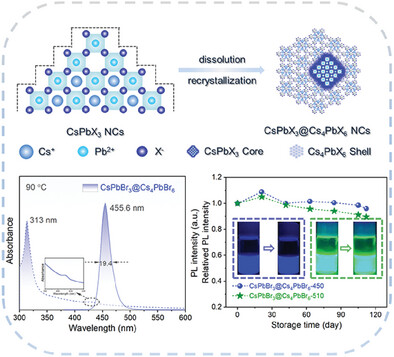
Blue-emitting CsPbBr3@Cs4PbBr6 core/shell NCs with high brightness and excellent stability are obtained by controlling the dissolution-recrystallization of CsPbBr3 nanoplatelets. The emission color of core-shell NCs is adjusted into green, orange, and red by controlling temperature, solvent viscosity, OLA, and halogen. These core/shell NCs exhibit excellent stability and great application prospects in the field of display.
Freeze Metal Halide Perovskite for Dramatic Laser Tuning: Direct Observation via In Situ Cryo-Electron Microscope
- First Published: 24 June 2024
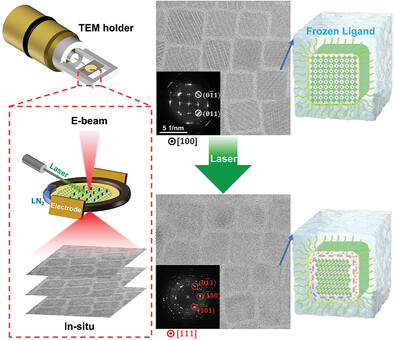
A frozen-temperature laser tuning method (below −28 °C) is developed to achieve giant functionality optimization and stability enhancement (>100 times) of metal halide perovskites (MHPs) for various applications. Freezing allows precise control over laser effects, enhancing CsPbBr3 nanocube arrays. The laser tuning mechanism is revealed by in situ cryo-TEM at atomic resolution.
Polymeric Cholesteric Superhelix Induced by Chiral Helical Polymer for Achieving Full-Color Circularly Polarized Room-Temperature Phosphorescence with Ultra-High Dissymmetry Factor
- First Published: 17 June 2024
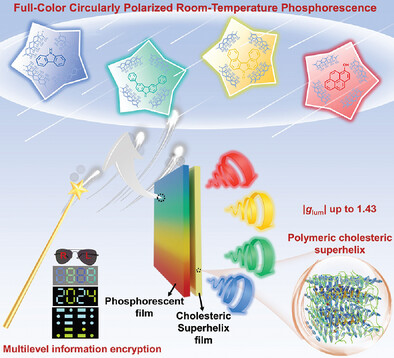
Full-color circularly polarized room-temperature phosphorescence with ultra-high dissymmetry factors (|glum| up to 1.43) is achieved by adopting double-layered architectures consisting of the polymeric cholesteric superhelix film induced by chiral helical polymer and phosphorescent films. Multilevel information encryption application is demonstrated based on the multidimensional optical characteristics of the CPRTP architectures.
Ultrasmall Metal TPZ Complexes with Deep Tumor Penetration for Enhancing Radiofrequency Ablation Therapy and Inducing Antitumor Immune Responses
- First Published: 19 June 2024

This study prepares Fe-TPZ nanoparticles by a one-step complexation method for synergistic enhancement of RFA tumor immunotherapy. Fe-TPZ not only exhibits improved physical and chemical properties, but also disrupts the balance of intracellular redox system through Fenton reaction, promotes activation through hypoxic microenvironment, and activates anti-tumor immune response to treat residual tumors and reduce metastasis.
Symmetrically Fluorinated D-π-A Structured Cyanine Dye for Highly Efficient NIR-II Imaging-Guided Cancer Phototheranostics
- First Published: 22 June 2024

The multi-faceted abilities of NPIR1116, encompassing symmetrical stability, high biocompatibility, non-toxic nature, and position them as trailblazers in the realm of cancer treatment. This novel PTA, with its capabilities for live blood vessel imaging and efficient real-time tumor ablation, is a rarity in current reports and signifies a breakthrough in high-precision, non-invasive, real-time image-guided diagnosis and therapies.
Defect-Rich Metastable MoS2 Promotes Macrophage Reprogramming in Breast Cancer: A Clinical Perspective
- First Published: 18 June 2024
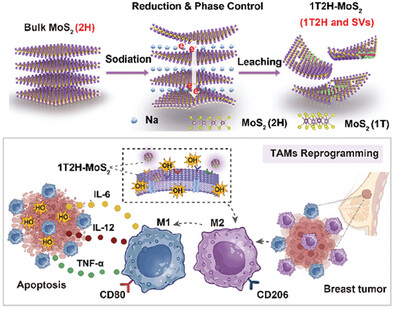
Defect-rich metastable MoS2 nanozymes (1T2H-MoS2) are designed via reduction and phase transformation in molten sodium. The clinical feasibility of 1T2H-MoS2 via ex vivo therapeutic responses is demonstrated as a guide treatment for human breast cancer. The 1T2H-MoS2 can function as an extracellular hydroxyl radical generator, efficiently repolarizing TAMs to the M1-like phenotype and directly killing cancer cells.
Electrical Polarity Modulation in V-Doped Monolayer WS2 for Homogeneous CMOS Inverters
- First Published: 25 June 2024

Vanadium atoms are controllably introduced into monolayer WS2 to achieve continuous electrical polarity modulation. Field-effect transistors based on the 4.7 at% V-doped WS2 show outstanding p-type performance. Expanding on this triumph, the inaugural prototype of a monolayer homogeneous complementary metal-oxide-semiconductor (CMOS) inverter device is constructed through atomic substitutional doping in transition metal dichalcogenides (TMDs).
Interactive Deformable Colored Sound Display Achieved with Electrostrictive Fluoropolymer and Halide Perovskite
- First Published: 20 June 2024
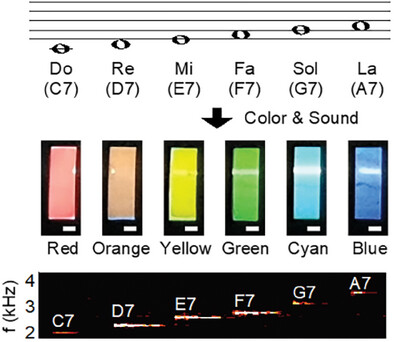
A deformable colored sound display is presented by utilizing alternating-current electroluminescence (ACEL) and halide perovskite composite films. The device generates diverse colors with sound at single electric field. The association of color and sound is demonstrated by playing music and notifying the safety state.
Enthralling Anodic Protection by Molybdate on High-Entropy Alloy-Based Electrocatalyst for Sustainable Seawater Oxidation
- First Published: 25 June 2024
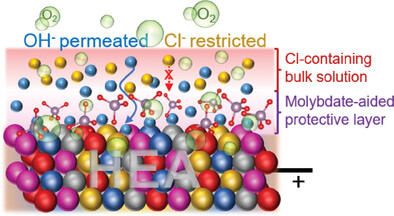
Highly active novel NiFeCrVMn high entropy alloy embedded in layered double hydroxide is identified as an electrocatalyst for alkaline seawater oxidation. Additionally, the use of a trace amount of molybdate as an inhibitor in electrolyte provides much-needed anodic protection against chloride corrosion offering sustainable seawater oxidation in industry-level operational parameters.
Centrifugation-Mediated Crystal Growth of Attractive Colloids for Band Edge Lasing
- First Published: 19 June 2024
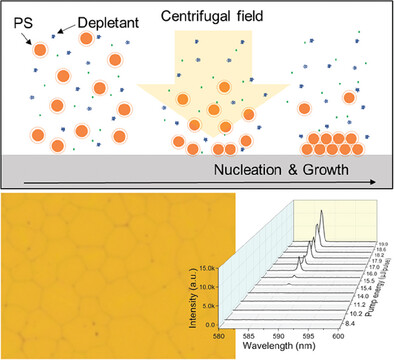
Colloidal photonic crystals with uniform orientation and high surface coverage are produced by applying centrifugal force during the depletion-induced assembly of polystyrene particles. This force encourages the particles to move toward the bottom surface, facilitating heterogeneous nucleation and rapid unidirectional crystal. These high-quality colloidal crystals enable band-edge lasing with a narrow spectral emission.
What Matters to Fabrication of Type II Porous Liquids: A Case Study on Metallocages and Bulky Ionic Liquid?
- First Published: 21 June 2024
Chondroitin Sulfate-Modified Hydroxyapatite for Caspase-1 Activated Induced Pyroptosis through Ca Overload/ER Stress/STING/IRF3 Pathway in Colorectal Cancer
- First Published: 17 July 2024
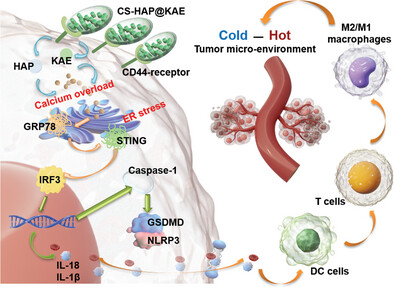
CS-HAP@KAE NPs selectively target CRC cells via CS-CD44 interactions, triggering HAP-mediated Ca release under TME stimuli. In addition, KAE perturbs Ca homeostasis, prompting extracellular Ca influx and intracellular Ca overload, which instigates ER stress and STING/IRF3 signaling. Consequently, NLRP3/caspase-1/GSDMD axis activation elicits pyroptosis of tumor cells, secreting inflammatory mediators, converting the “cold” TME to “hot”, and potentiating CRC immunotherapy efficacy.
Modulation of Charge Redistribution in Heterogeneous CoSe-Ni0.95Se Coupling with Ti3C2Tx MXene for Hydrazine-Assisted Water Splitting
- First Published: 22 June 2024
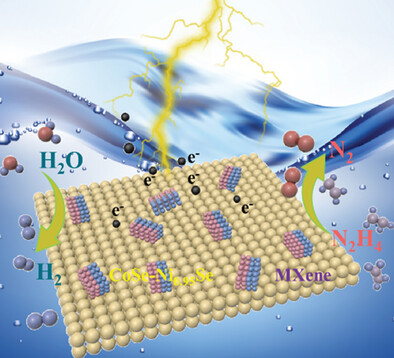
The present work exhibits an efficient strategy by coupling of heterogeneous CoSe-Ni0.95Se with MXene to significant enhance interfacial electronic field, thus dual nucleo/electrophilic sites are integrated into a single transition metal selenide, which facilitates the free energy of H* adsorption and optimizes the dehydrogenation kinetics of N2H4*, thereby speeding up the HER and HzOR for overall hydrazine splitting.
Robust and Lubricating Interface Semi-Interpenetrating Network on Inert Polymer Substrates Enabled by Subsurface-Initiated Polymerization
- First Published: 20 June 2024
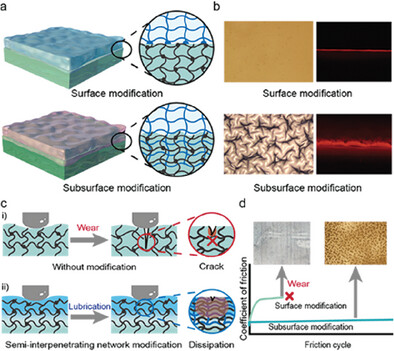
Hydrogel coatings merge the surface lubrication with the substrate's mechanical properties. However, their loose networks always bring about surface wear problems. Based on a good solvent swelling and subsurface-initiated polymerization method, a robust lubricating hydrogel coating is developed with an interface semi-interpenetrating network between gel and diverse polymer substrates, to greatly suppress crack and expand wear resistance by entangled chain dissipations, outperforming traditional surface modifications.
An Organic–Inorganic Hydrogel with Exceptional Mechanical Properties via Anion-Induced Synergistic Toughening for Accelerating Osteogenic Differentiation
- First Published: 19 June 2024

Drawing inspiration from the structure and mechanical features of mineralized tissues, an organic–inorganic hybrid hydrogel synthesized via anion-induced simultaneous mineralization and salting-out processes is introduced. The synergistic toughening imparts exceptional mechanical properties and biocompatibility to the hydrogel, showcasing its potential for various biological applications, such as the facilitation of in vitro mineralization of human adipose-derived mesenchymal stem cells.
Enhanced Temperature Stability of Pyroelectric Sensing in Multilayer Potassium Sodium Niobate-Based Ceramics with Graded Polarization Rotation
- First Published: 20 June 2024
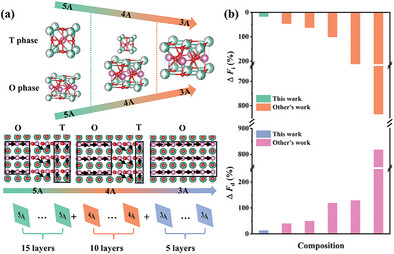
Excellent pyroelectric and FOMs temperature stability is achieved by designing multilayer potassium sodium niobate -based ceramics, which is superior to other pyroelectric ceramic systems. The excellent temperature stability can be attributed to the graded polarization rotation states among each lamination induced by successive phase transitions.
In-Situ Gas Permeation-Driven Ionic Current Rectification of Heterogeneously Charged Nanopore Arrays
- First Published: 20 June 2024
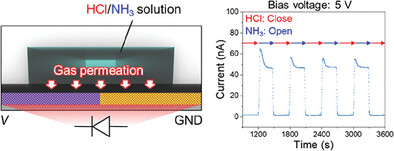
Gas permeation through a polymeric film into an ionic diode dynamically and reversibly manipulates ionic current rectification (ICR). This process, coupled with an automated gas permeation controller, allows for the manipulation of ion transport. This approach further shows significant potential for the simultaneous operation of multiple ionic diodes/components by individually adjusting the gas permeation controller. It paves the way for more efficient and versatile control of ion transport processes.
Self-Assembly of Super-Uniform Covalent Organic Framework Colloidal Particles into Multi-Dimensional Ordered Superstructures
- First Published: 19 June 2024
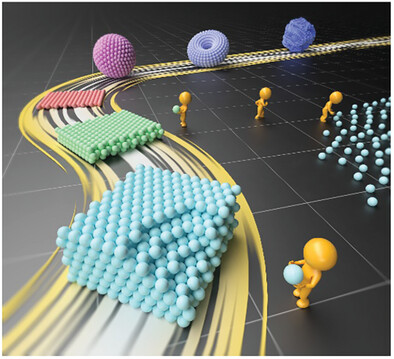
Simple and versatile strategies are proposed for synthesis of super-uniform COF colloidal particles and self-assembly of them into 1D supraparticles, 2D ordered mono/multilayers, and 3D COF films. These superstructures demonstrate long-range periodicity while preserving their porosity and high specific surface area. The feasibility of the strategies is examined with different types of COFs.
Regulating Water Adsorption Sites of Keto-Enamine COF by Base Exfoliation and Deprotonation for Enhanced Humidity Response
- First Published: 20 June 2024
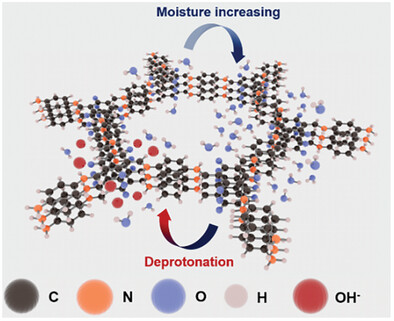
TpPa-1 COF exhibits adjustable water adsorption sites after exfoliation and deprotonation, which increases the response and recovery speed in humidity sensors for respiration detection. Water molecules tend to accumulate in the 1D pores in deprotonated TpPa-1 COF, leading to linear adsorption and quicker desorption at a low % RH environment.
Fluorinated Co-Solvents Enable Excellent Performances of Practical Cells Comprising LixSiO-Graphite Composite Anodes and LiNi0.89Co0.05Mn0.05Al0.01O2 (NCMA) Cathodes
- First Published: 25 June 2024
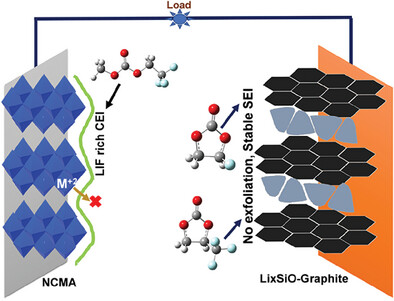
Li-ion batteries electrochemical performances strongly depend on the electrolyte composition. The fluorinated based electrolytes are developed and compared to the EC-based systems, fluorinated compositions promote the formation of excellent protecting layers on the surface of the cathodes and anodes. Fluorinated electrolyte compositions mitigates the parasitic reactions, gas evolution, and avoids the dissolution of transition metal ions.
Abnormal Magnetic Phase Transition in Mixed-Phase (110)-Oriented FeRh Films on Al2O3 Substrates via the Anomalous Nernst Effect
- First Published: 22 June 2024
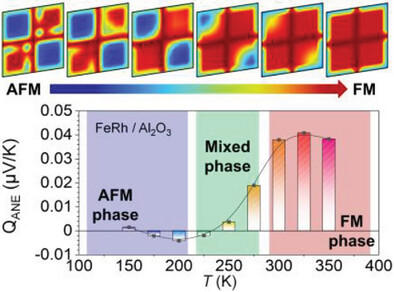
Here, the anomalous Nernst effect in the 25-nm-thick (110)-oriented FeRh thin films is observed, which is a result of a spontaneous drop in the transverse voltage driven by the temperature gradient in a magnetic material, over a temperature range of 100–350 K. To elucidate the causes of this phenomenon further, various experimental and theoretical analyses are successfully performed.
Bioactive Calcium Hydride-Driving “Triple” Hydrogen/Alkaline/Calcium Therapy for Efficient Treatment of Osteomyelitis
- First Published: 22 June 2024
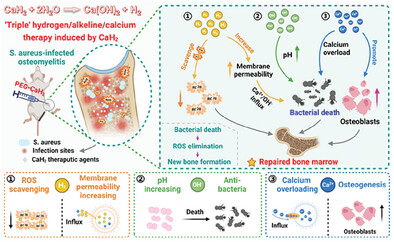
Bioactive calcium hydride-driving ‘triple’ hydrogen/alkaline/calcium therapy for efficient treatment of osteomyelitis. CaH2 reacts with water to generate an alkali environment with OH− to induce bacterial death. The byproduct H2 molecules enhance bacterial membrane permeability and scavenge excess ROS, and the released Ca2+ first cause intra-bacterial calcium overload and subsequently promote new bone formation.
Defect Engineered Bi2Te3 Nanosheets with Enhanced Haloperoxidase Activity for Marine Antibiofouling
- First Published: 27 June 2024
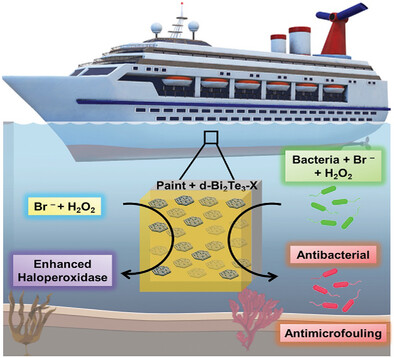
Haloperoxidase (hPOD) activity is imparted, in otherwise inactive Bi2Te3 nanosheets, via controlled NaOH (X) etching. Defective (d) d-Bi2Te3-X exhibits a maximum of eight times higher hPOD performance than as-grown Bi2Te3. The optimum d-Bi2Te3-250 displays effective bactericidal and antimicrofouling properties in real maritime settings, showcasing the potential for defect-engineering in non-transition metal chalcogenides for active catalysis.
Hofmeister Effect-Assisted Facile Fabrication of Self-Assembled Poly(Vinyl Alcohol)/Graphite Composite Sponge-Like Hydrogel for Solar Steam Generation
- First Published: 21 June 2024
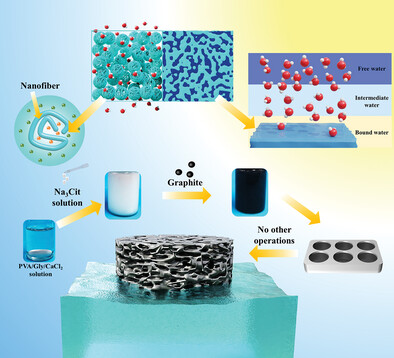
This paper presents a novel and facile method for obtaining a sponge-like hydrogel with excellent pore structure, outstanding water transport and solar interfacial evaporation performance. The method is based on the Hofmeister effect, whereby the polymer nanofibers are coiled by a combination of salting and salting effects, resulting in the formation of a pore structure.
Zincophilic Nanospheres Assembled as Solid-Electrolyte Interphase on Zn Metal Anodes for Reversible High-rate Zn-Ion Storage
- First Published: 28 June 2024
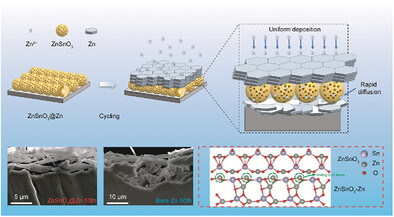
ZnSnO3 hollow nanospheres is grown on the surface of zinc foil as a zinc anode solid-electrolyte interface by a simple two-step hydrothermal method. During the cycling process, ZnSnO3 can induce the uniform deposition of active zinc on the electrode surface, while providing a fast ion diffusion channel to improve the kinetic performance. And the binding energy of ZnSnO3-Zn is calculated by the density functional theory (DFT) to study the mechanism of uniform deposition of zinc.
Design and Performance of Small-Molecule Donors with Donor–π-Acceptor Architecture Toward Vacuum-Deposited Organic Photovoltaics Having Heretofore Highest Short-Circuit Current Density
- First Published: 20 June 2024
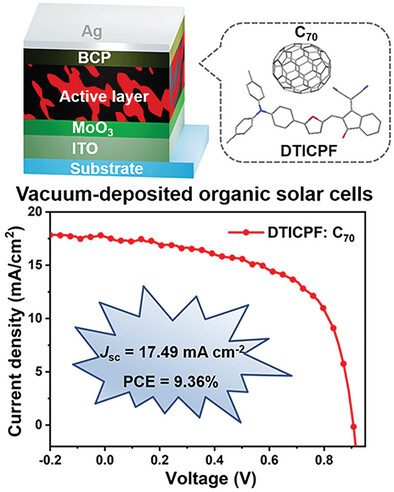
A novel D-π-A configured small-molecule donor DTICPF is developed, which exhibits strong and broad optical absorption, and deep highest occupied molecular orbital (HOMO) energy levels. Vacuum-deposited organic solar cells (OSCs) based on DTICPF: C70 display power conversion efficiency (PCE) of 9.36% (certified 9.15%) with short-circuit current density (Jsc) up to 17.49 mA cm−2, which is the highest Jsc reported so far for vacuum-deposited OSCs.
Pre-Corrosion of Zinc Metal Anodes for Enhanced Stability and Kinetics
- First Published: 22 June 2024
Exploring Phenolphthalein Polyarylethers as High-Performance Alternative Binders for High-Voltage Cathodes in Lithium-Ion Batteries
- First Published: 20 June 2024
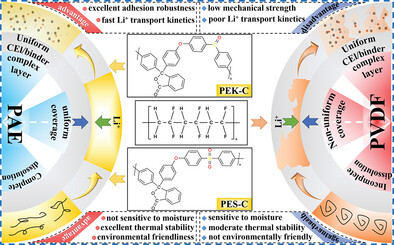
This work introduces phenolphthalein polyarylethers as a high-performance alternative binder for high-voltage cathodes. With its excellent electrochemical oxidation resistance and robustness adhesion, phenolphthalein polyarylethers establish an effective ion-conductive CEI/binder composite layer. It effectively mitigates adverse reactions at the cathode-electrolyte interface, reduces voltage polarization, and enhances the cycling and rate performance and ion diffusion kinetics of the cells.
Oral Heterojunction Coupling Interventional Optical Fiber Mediates Synergistic Therapy for Orthotopic Rectal Cancer
- First Published: 20 June 2024
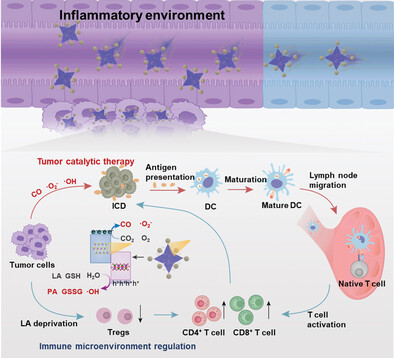
Fiber–optic interventional technology-mediated heterojunction nanomedicine efficiently produces ROS and CO, using LA and GSH as electron donors. This heterojunction nanomedicine not only induces immunogenic cell death in tumor cells but also destroys the immunosuppressive tumor microenvironment mediated by high LA concentrations, achieving synergistic catalysis and immunotherapy for in situ rectal cancer treatment.
Joint Exfoliation of MXene by Dimensional Mismatched SiC/ZIF-67 Toward Multifunctional Flame Retardant Thermoplastic Polyurethane
- First Published: 21 June 2024
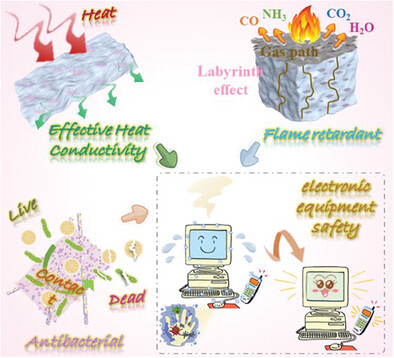
A monolayer of MXene@SiC@ZIF material is prepared by the concept of dimensional mismatch and joint exfoliation. And according to the previous work, polyaniline (PANI) is generated by in situ polymerization on the surface of ZIF-67 to obtain MXene@SiC@PANI nano-hybrid material. The thermally conductive, flame retardant, and antibacterial properties of thermoplastic polyurethane are effectively improved.
Scanning Electrochemical Probe Lithography for Ultra-Precision Machining of Micro-Optical Elements with Freeform Curved Surface
- First Published: 28 June 2024
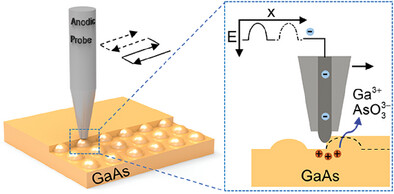
An innovative microfabrication methodology integrating the principles of scanning probe microscopy and local anodic corrosion is proposed to manufacturing freeform surface at gallium arsenide. The etching rate is well controlled by predetermined voltages throughout the scanning motion, resulting high machining accuracy, and demonstrating its competitiveness in the fabrication of functional optical device directly on semiconductor wafers.
Improved Urea Oxidation Performance via Interface Electron Redistributions of the NiFe(OH)x/MnO2/NF p-p Heterojunction
- First Published: 25 June 2024
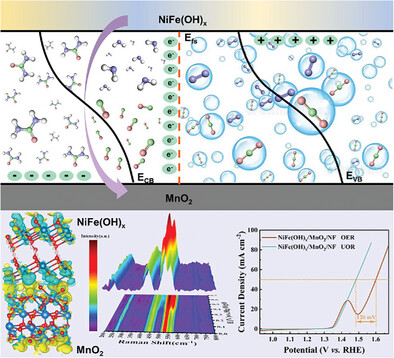
The NiFe(OH)x/MnO2 p-p heterojunction structure with a large band difference is constructed to induce directional electron transfer redistribution (NiFe(OH)x to MnO2), promote the adsorption of reactant /intermediate, optimize the reaction barrier of the rate-controlling step and reduce the formation potential of Ni3+ active phase to support efficient urea oxidation reaction (UOR).
Stable Radicals in Dihydrophenazine Derivatives-Doped Epoxy Resin for High Photothermal Conversion
- First Published: 20 June 2024
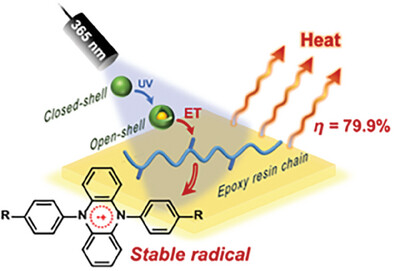
This work uses dihydrophenazine derivatives as dopants to build a series of co-doped epoxy resins. Under the UV excitation, dihydrophenazine derivatives generate radicals through an electron transfer process, which are stabilized by epoxy resin chains. The photothermal conversion efficiency of this process reaches 79.9%. This kind of material shows potential applications in transparent greenhouses and photovoltaic conversion.
Efficient Sorting of Semiconducting Single-Walled Carbon Nanotubes in Bio-Renewable Solvents Through Main-Chain Engineering of Conjugated Polymers
- First Published: 27 June 2024
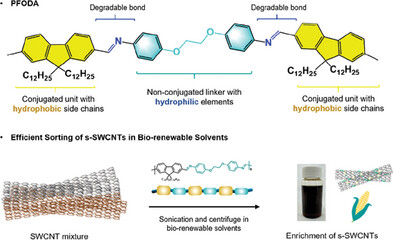
Hydrophilic linker-incorporated conjugated polymers are developed for sorting single-walled carbon nanotubes (SWCNTs) using bio-renewable solvents. The introduction of ethylene glycol chains enhances solubility, facilitating effective wrapping of SWCNTs in polar environments. The polymer achieves a high sorting yield of 55% and a purity of 99.6% when dispersing semiconducting SWCNTs in 2-Methyltetrahydrofuran.
A Universal Strategy for Constructing Hydrogel Assemblies Enabled by PAA Hydrogel Adhesive
- First Published: 22 June 2024

The construction of traditional hydrogel assemblies relies on the introduction of supramolecular groups for specific recognition interactions, which limits the widespread application of hydrogel assemblies. Herein, PAA hydrogel is utilized as an adhesive layer to assemble different types of hydrogels, enabling the construction of hydrogel assemblies.
Light-Induced Material Motion Fingerprint – A Tool Toward Selective Interfacial Sensitive Fractioning of Microparticles via Microfluidic Methods
- First Published: 05 July 2024
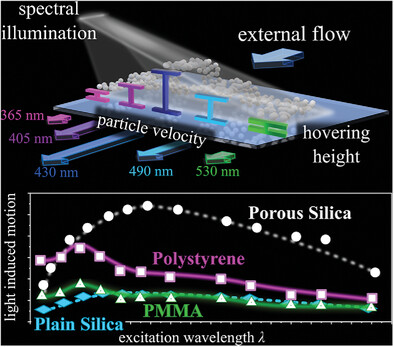
A method is demonstrated for separating microparticles and microplastics distinguished differences in surface morphology (roughness, particles bulk material, and surface functionalization). The method uses advances of microfluidics in combination with illumination of a photosensitive surfactant solution within the shear flow. Spectrally resolved, this yields a light-induced material motion fingerprint allowing a selective fractioning of microparticles via difference in velocity.
Molybdenum-Doped Cobalt-Free Cathode Realizing the Electrochemical Stability by Enhanced Covalent Bonding
- First Published: 20 June 2024
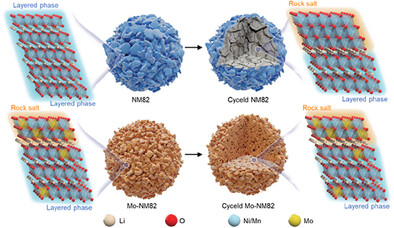
A unique Mo-doped LiNi0.8Mn0.2O2 is developed with delocalized 4d electrons, which reinforces the Mo─O bond through increased covalency, thereby reducing oxygen mobility during cycling. Moreover, gradient Mo distribution enables the construction of surface cation mixing layer to avoid the electrolyte attack and stabilize the lattice structure during the lithium extraction.
Unconventional Magnetic and Magneto-Transport Properties in Quasi-2D Ni0.28TaSeS Single Crystal
- First Published: 25 June 2024
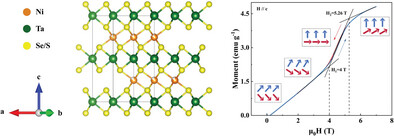
By intercalating Ni atoms into the 2H-TaSeS van der Waals interlayers, the quasi-two-dimensional Ni0.28TaSeS single crystals are obtained. Magnetic characterization reveals a canted magnetic structure in Ni0.28TaSeS, resulting in an antiferromagnetic order along the c-axis and a net ferromagnetic moment in the ab-plane. Furthermore, the Ni0.28TaSeS single crystals also exhibit unconventional magneto-transport properties.
Unveiling Mechanistic Insight into Accelerating Oxygen Molecule Activation by Oxygen Defects in Co3O4-x/g-C3N4 p–n Heterojunction for Efficient Photo-Assisted Uranium Extraction from Seawater
- First Published: 07 July 2024
Semi-Ionic F Modified N-Doped Porous Carbon Implanted with Ruthenium Nanoclusters toward Highly Efficient pH-Universal Hydrogen Generation
- First Published: 27 June 2024
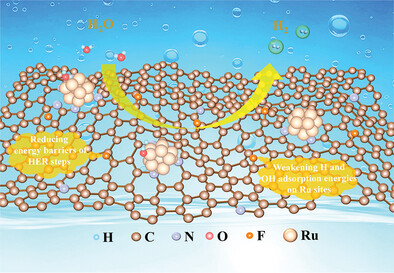
This work introduces a hydrogel sealing-pyrolying-etching strategy to construct the semi-ionic F-modified Ru/N-doped porous carbon catalysts (Ru/FNPC). The Ru/FNPC exhibits exceptional electrocatalytic performances in pH-universal hydrogen evolution reaction (HER). The semi-ionic F in Ru/FNPC stimulates the HER kinetics on Ru sites by lowering the energy barriers of HER steps and decreasing the adsorption energies of key intermediates.
Ultra-Rapid Electrocatalytic H2O2 Fabrication over Mono-Species and High-Density Polypyrrolic-N Sites
- First Published: 21 June 2024

High-density and mono-species pyrrolic nitrogen species lead to outstanding electrocatalytic performance for 2e−-ORR. The associated kinetic inhibition of the competitive HER and 4e−-ORR results in the high H2O2 yield of this catalyst over a wide potential range. A record-high H2O2 yield of up to 67.9 mol g−1 h−1 is achieved, resulting in an unprecedentedly high H2O2 concentration of 13.47 g L−1 over 24 h.
Nest-Scheme RuIrLa Nanocrystals by NP-to-NP Oriented Assembly: Coherent Strain Fields-Driven Band Structure Splitting for Efficient Acidic Water Oxidation
- First Published: 26 June 2024

Rare-earth microalloying nanocrystals with customizable defect nanostructures and segmented energy bands are considered to be an ideal type of electrocatalyst for oxygen evolution reactions and have received widespread attention. Herein, nest-scheme RuIrLa with dense coherent interfaces as built-in substructures are firstly fabricated by using commercial ZnO particles as acid-removable templates, through a La-stabilized coherent epitaxial growth of nanoparticles (NPs).
Optimal Oxophilicity at the Fe-Nx Interface Enhances the Generation of Singlet Oxygen for Efficient Fenton-Like Catalysis
- First Published: 07 July 2024
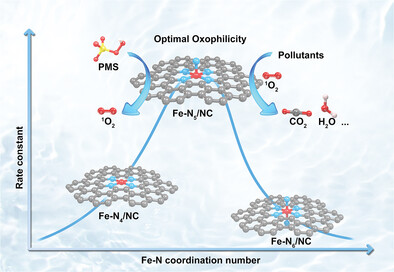
Singlet oxygen (1O2) is highly effective when contemplating the selective removal of organic pollutants from wastewater by Fenton-like catalysis. Here, the optimal performance of the Fe-N5/NC single-atom catalysts (SACs) than the other SACs in activating peroxymonosulfate for the degradation of organic pollutants is reported. The axial-N in Fe-N5/NC reduces the oxophilicity of the Fe-center, hence accelerating the release of 1O2 in the rate-determining step.
Boosting Electrochemical Nitrate Reduction at Low Concentrations Through Simultaneous Electronic States Regulation and Proton Provision
- First Published: 23 June 2024
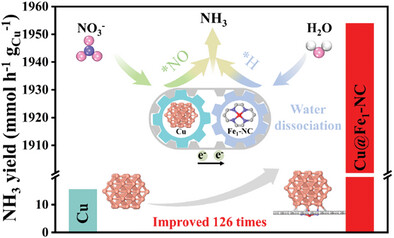
A tandem catalyst Cu@Fe1-NC is prepared with co-existed Cu nanoparticles and dispersed single Fe atoms on N-doped carbon boosting the electroreduction of NO3− to NH3 in dilute NO3− solutions (≤100 ppm NO3−-N, ≈7.1 mm). The optimized Cu@Fe1-NC presents a FENH3 of 97.7% at −0.4 V versus RHE and a record-high NH3 yield of 1953.9 mmol h−1 gCu−1, superior over the pristine Cu (FENH3 = 25.1%, 15.5 mmol h−1 gCu−1).
Reduction of Oxidative Stress and Excitotoxicity by Mesenchymal Stem Cell Biomimetic Co-Delivery System for Cerebral Ischemia-Reperfusion Injury Treatment
- First Published: 01 July 2024
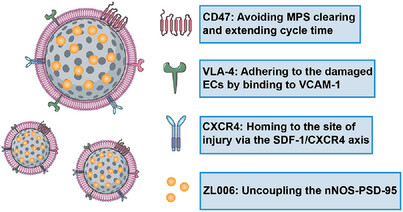
A novel biomimetic delivery system is developed by coating mesenchymal stem cell membrane onto prussian blue nanoparticles loaded with neuroprotectant. The system enhances brain penetration, targets ischemic penumbra and clears reactive oxygen species in the early stage of ischemic stroke, alleviating the brain injury caused by oxidative stress, reducing cerebral infarction and cerebral edema, and inhibiting neuronal apoptosis.
Large-Scale Engineerable Films Tailored with Cellulose Nanofibrils for Lighting Management and Thermal Insulation
- First Published: 26 June 2024
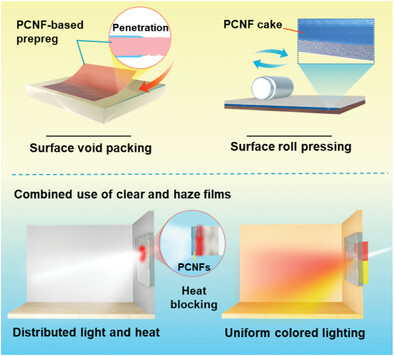
Phosphorylated cellulose nanofibril (PCNF)-based clear film with an extremely low haze are obtained by surface void packing, and PCNF gel cakes serve here as templates for surface roughening to achieve high haze values. Obtained films can tune distribution of light from visible to near-infrared spectral range, enabling uniform colored lighting and heat blocking.
Redox Promoted Rapid and Deep Reconstruction of Defect-Rich Nickel Precatalysts for Efficient Water Oxidation
- First Published: 28 June 2024
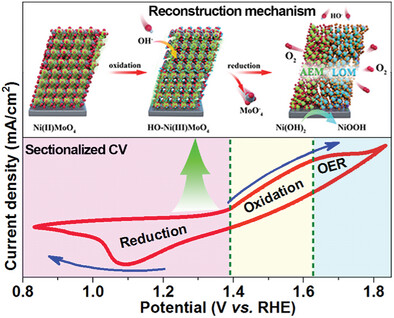
Ni redox promoting the rapid and deep reconstruction of NiMoO4 is revealed by a sectionalized CV method, and the reconstruction mechanism is proposed based on the acid-base electronic theory. According to the reconstruction mechanism, the dominant contribution of the adsorbate evolution mechanism (AEM) to the reconstruction of NiMoO4 during oxygen evolution is uncovered.
Observation of a Reversible Order-Order Transition in a Metal-Organic Framework – Ionic Liquid Nanocomposite Phase-Change Material
- First Published: 26 July 2024
Tunable and Non-Invasive Printing of Transmissive Interference Colors with 2D Material Inks
- First Published: 26 June 2024
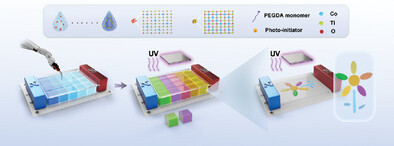
Printing interference colors entails complex procedures and large-scale printing systems for the scarcity of inks that exhibit both sensitivity and tunability to external fields. This work invents a type of paramagnetic ink with record-level magneto-optical sensitivity based on 2D materials. These inks exhibit polychrome in one magnetic field, paving the way for preparing transmissive interference colors in an energy-saving and damage-free manner.
Maintaining the 2D Structure of MXene via Self-Assembled Monolayers for Efficient Lubrication in High Humidity
- First Published: 27 June 2024
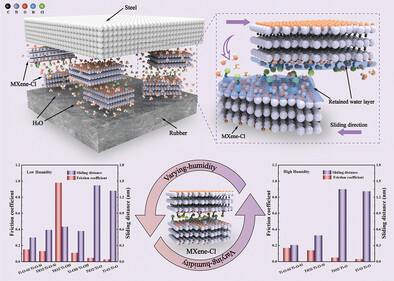
The self-assembled monolayers are conducted on MXene by surface chlorination or fluorination, aiming to improve its friction performance in high humidity. Interestingly, the MXene-Cl with moderate water resistance maintains a relatively lower CoF under both high and low-humidity conditions, which is attributed to the preservation of 2D layered structure, the increased layer spacing, and the adsorption of nanostructured water.
Tuning Octahedron Sites of CoV2O4 via Cationic Competition for Efficient Oxygen Evolution Reaction
- First Published: 01 July 2024
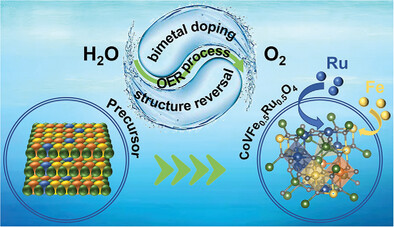
The well-designed CoVFe0.5Ru0.5O4 exhibits exceptional oxygen evolution reaction (OER) activity and stability, which can be attributed to the incorporation of Fe and Ru cations replacing the octahedral sites of CoV2O4. This substitution effectively reduces the reaction energy barrier, weakens the oxygen desorption energy, enhances the electrical conductivity, and provides abundant active sites.
Crystallographic Pathways to Tailoring Metal-Insulator Transition through Oxygen Transport in VO2
- First Published: 10 July 2024

The facilitated oxygen transport through crystallographic open channels in rutile is investigated. Oxygen ions are diffused out of two VO2 films; one with channels oriented toward the surface (channeling VO2) and the other with channels parallel to the surface (anti-channeling VO2). In channeling VO2 film, the formation of oxygen vacancies and consequent tuning of metal-insulator transition properties are promoted by facilitated oxygen transport.
All-Organic Piezo-Photocatalytic Film with Highly Efficient Catalysis, Weak-Force Excitation, and Recyclability
- First Published: 15 July 2024
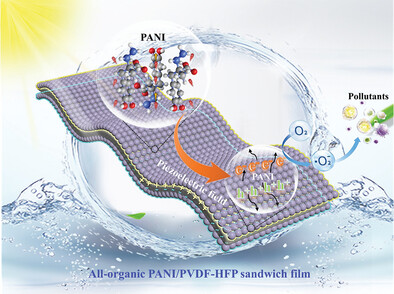
Piezo-photocatalytic films of polyaniline (PANI) are fabricated to improve their photocatalytic performance. The poly(vinylidene fluoride-co-hexafluoropropylene) (PANI/PVDF-HFP) sandwich film results in 91.2% degradation of MO under magnetic stirring. This all-organic piezo-photocatalyst is easy to be recycled and responds to weak forces, realizing self-powered environmental purification.
Circulating B Cell-Derived Small RNA Delivered by Extracellular Vesicles: A Dialogue Mechanism for Long-Range Targeted Renal Mitochondrial Injury in Obesity
- First Published: 03 July 2024
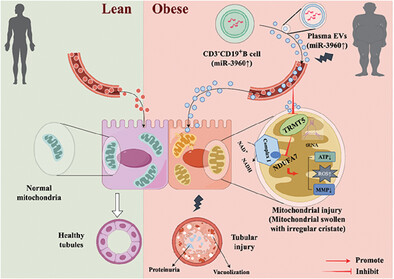
Unraveling the novel mechanisms will address the pressing demand of identifying promising therapeutic avenue for obesity-related kidney disease. Compared with lean subjects, CD3−CD19+ B cell-derived miR-3960 transported by plasma EVs in patients with obesity serve as a circulating pathogenic factor in mediating mitochondrial injury via TRMT5/NDUFA7 axis, ultimately leading to renal tubular injury.
High-Performance 2D Ambipolar MoTe2 Lateral Memristors by Mild Oxidation
- First Published: 03 July 2024
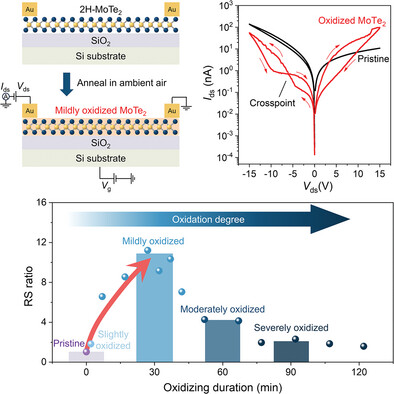
An effective and feasible strategy, mild oxidation, is developed to enhance the resistance switching performance of 2D ambipolar 2H-MoTe2 lateral memristors. The resistance switching ratio is enlarged by more than 10 times. Besides, the ambipolarity of 2H-MoTe2 also enables a change of resistance switching direction. High-performance artificial synapse is thus achieved and high-accuracy handwritten digit recognition (>96%) is realized.
Thiocarbonyl-Based Hole Transport Materials with Enhanced Defect Passivation Ability for Efficient and Stable Perovskite Solar Cells
- First Published: 27 June 2024
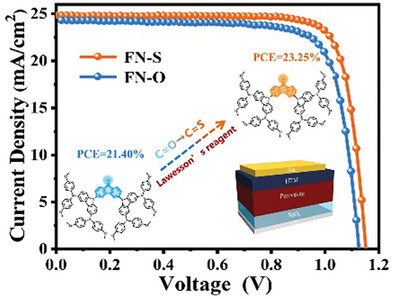
The treatment of FN-O with Lawesson's reagent into FN-S, which converts carbonyl to thiocarbonyl, affects the electronic properties of FN-S. This leads to a stronger interaction between FN-S and the perovskite, providing FN-S with a stronger defect passivation capability, and thus improving the efficiency of PSCs.
Highly Emissive Lanthanide-Based 0D Metal Halide Nanocrystals for Efficient Ultraviolet Photodetector
- First Published: 25 June 2024
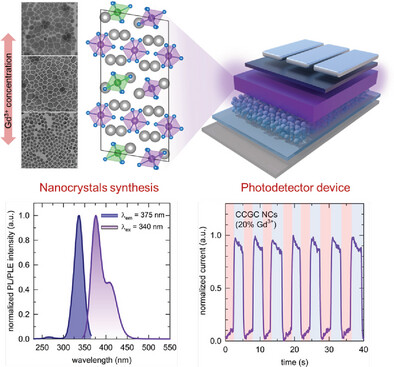
Cs3CeCl6 (CCC) nanocrystals (NCs) possess fascinating optical properties due to their f–d coupling of Ce3+ ions. The incorporation of Gd3+ in CCC NCs can be a facile method to enhance photoluminescence quantum yield (PLQY) up to almost unity (96%) as well as the phase stability. This Cs3Ce1-xGdxCl6 alloyed NCs exhibits efficient device performance as a UV-light absorbing layer for photodetector with detectivity (7.938 × 1011 Jones) and responsivity (0.195 A W−1) at -0.1 V bias at 310 nm.
3D Printing of Thermo-Mechano-Responsive Photoluminescent Noncovalent Cross-Linked Ionogels with High-Stretchability and Ultralow-Hysteresis for Wearable Ionotronics and Anti-Counterfeiting
- First Published: 23 June 2024
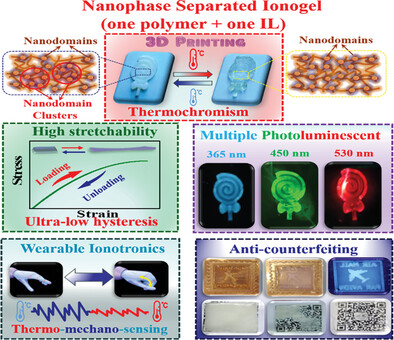
A simple and innovative strategy based on phase separation is developed to prepare multifunctional noncovalent cross-linked ionogels by 3D printing of HPA in BMIMBF4. These ionogels show remarkable stretchability, ultra-low hysteresis, excellent temperature tolerance, extraordinary ionic conductivity, and outstanding durability. Furthermore, the ionogels exhibit unique thermochromic and multiple photoluminescent properties, which can synergistically be applied for thermo-mechano-multimodal ionotronics and anti-counterfeiting.
Uncovering Temperature-Insensitive Feature of Phase Change Thermal Storage Electrolyte for Safe Lithium Battery
- First Published: 25 June 2024
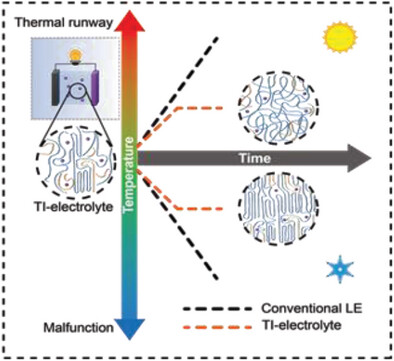
The safety concerns of Li-ion batteries persist in extreme temperatures. A temperature-insensitive electrolyte, comprising two phase-change polymers, demonstrates exceptional thermal resistance. It absorbs and releases heat, maintaining stability during high-temperature shocks. It minimizes temperature fluctuations in Li||LFP pouch cells, surpassing liquid electrolytes. These results position it as a crucial safety enhancement for LIBs in thermal abuse conditions.
Interacted Ternary Component Ensuring High-Security Eutectic Electrolyte for High Performance Sodium-Metal Batteries
- First Published: 27 June 2024
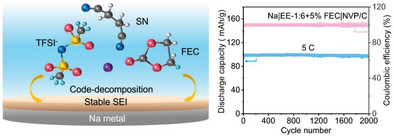
A flame-retardant ternary eutectic electrolyte composed of sodium bis(trifluoromethanesulfonyl)imide (NaTFSI), succinonitrile (SN), and fluoroethylene carbonate (FEC) is reported. SN makes the dissociation of NaTFSI and the fast transport efficiency of Na+ is greatly boosted. FEC effectively prevents the side reactions of electrolyte/electrode interface. The Na+ transport mechanism and excellent electrochemical performance are systematically verified by the combination of experimental and theoretical technologies.
Photoreceptor-Mimetic Microflowers for Restoring Light Responses in Degenerative Retina through a 2D Nanopetal/Cell Biointerface
- First Published: 26 June 2024
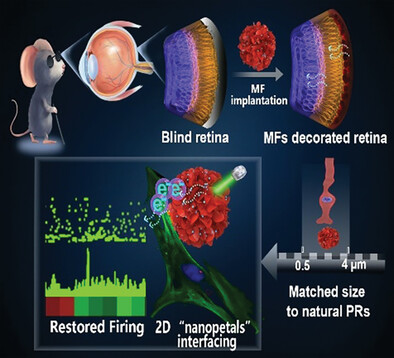
This work constructed a biomimetic photoelectric interface based on the graphene quantum dot-doped ZnIn2S4 microflowers (MFs), aiming to restore the light responses in photoreceptor (PR)-degenerative mice. The MFs have dimensions and dispersibility similar to those of natural PRs and can generate soft 2D nanopetal/cell bio interface. The MFs selectively restored specific retina ganglion cells and induced spiking and postsynaptic currents at the single-neuron level.
Aptamer and Thiol Co-Regulated Color-Shifting Fluorophores via Dynamic Through-Bond/Space Conjugation for Constructing Ratiometric RNA Sensor
- First Published: 25 June 2024
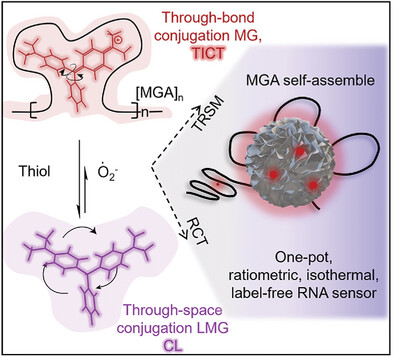
A simple strategy for deconjugating malachite green (MG) ligand in a reductive enzymatic environment is reported to manipulate the clusteroluminescence within isolated benzene rings. This strategy is then employed to construct a one-pot, ratiometric RNA sensor using an allosteric transcription-switch and rolling circle transcription. The RNA aptamer (MGA)-MG fluoresces red, while the reductive leucomalachite green (LMG) fluoresces in the UV region.
Bimetal Oxides Anchored on Carbon Nanotubes/Nanosheets as High-Efficiency and Durable Bifunctional Oxygen Catalyst for Advanced Zn–Air Battery: Experiments and DFT Calculations
- First Published: 01 July 2024
Lubricant-Coated Organ-on-a-Chip for Enhanced Precision in Preclinical Drug Testing
- First Published: 27 June 2024
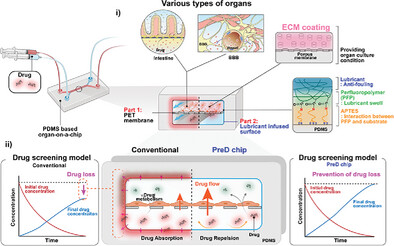
Human organ-on-a-chip technology has emerged as an essential tool for preclinical testing. PDMS is commonly used in organ chip fabrication. However, PDMS face challenge like unintended absorption of small molecules, critically affecting the drug response analysis. Addressing this, precision drug testing organ chip (PreD chip) is introduced, an innovative platform engineered to minimize small molecule absorption while facilitating cell culture.
Bio-Inspired Fluorescent Calcium Sulfate for the Conservation of Gypsum Plasterwork
- First Published: 28 June 2024
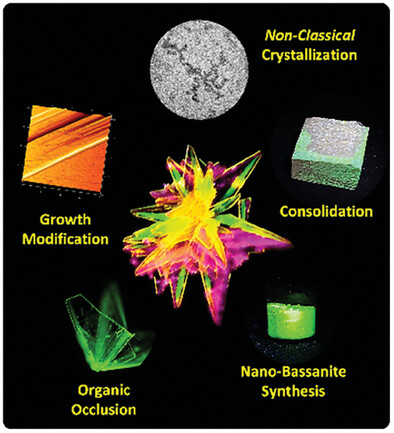
This study explores the nonclassical crystallization of calcium sulfates using calcein, aiming to develop bio-inspired methods for tailored consolidation products in heritage conservation. Through this investigation, fluorescent nano-bassanite (NB-C) consolidants are synthesized. These consolidants effectively enhance the mechanical strength and weathering resistance of deteriorated plasterwork. Additionally, the luminescence emitted by occluded calcein facilitates the straightforward identification of the consolidant within gypsum plaster under UV light.
Equilibrium Moisture Mediated Esterification Reaction to Achieve Over 100% Lignocellulosic Nanofibrils Yield
- First Published: 27 June 2024
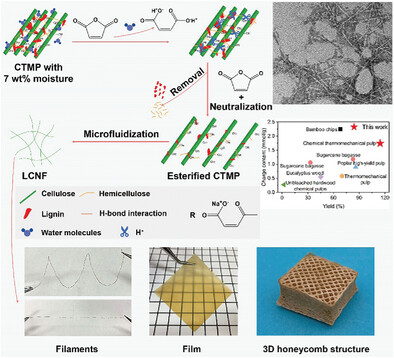
An esterification strategy mediated by the equilibrium moisture in biomass is proposed for the LCNFs preparation without the use of catalysts, resulting in a high yield (114.4 ± 3.0%) and charge content (1.74 ± 0.09 mmol g−1). The resulting LCNFs can be utilized as building blocks for filaments, film, and 3D printing sample assembly, enhancing the potential of biomass high-value conversion.
Heterogeneous Acrylic Resins with Bicontinuous Nanodomains as Low-Modulus Flexible Adhesives
- First Published: 26 June 2024
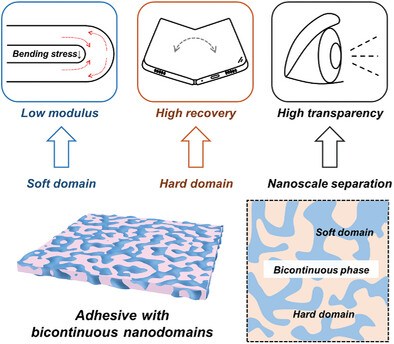
Innovative adhesives with bicontinuous nanodomains for flexible and low-modulus properties are created. Achieved through A polymerization-induced microphase separation with a macro chain transfer agent, this structure grants superb transparency and flexibility, ideal for foldable displays. It also hints at potential uses in stretchable displays and wearable electronics.
Achieving “Ion Diode” Salt Resistance in Solar Interfacial Evaporation by a Tesla Valve-Like Water Transport Structure
- First Published: 28 June 2024
Combining Trivalent Ion-Doping with Halide Alloying to Increase the Efficiency of Tin Perovskites
- First Published: 27 June 2024

The efficiency of tin iodide perovskite solar cells is severely limited by the native self p-doping. Here, based on density functional theory calculations, it is demonstrated that combining trivalent ion-doping with bromide alloying effectively decreases the hole background density and the density of deep traps, by providing useful guidelines to experimentalists for improving the optoelectronic quality of these materials.
Strong and Robust Core–Shell Ceramic Fibers Composed of Highly Compacted Nanoparticles for Multifunctional Electronic Skin
- First Published: 25 June 2024
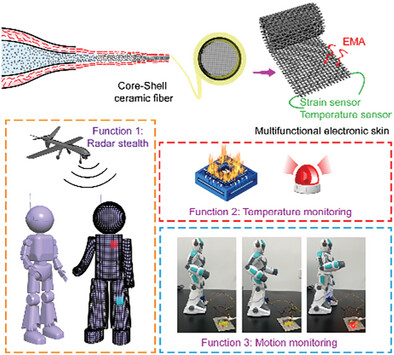
The core–shell ceramic fibers composed of highly compacted nanoparticles with excellent mechanical properties are prepared by coaxial wet spinning combined with cold isostatic pressing. Ceramic fiber integrates a variety of functionalities, including strain sensors, temperature sensors, and electromagnetic absorption. Thus, it can be used as a stable robotic electronic skin.
A 2D Metal-Free Inorganic Covalent Framework: Synthesis, Crystal Structure, and Room-Temperature Phosphorescence
- First Published: 28 June 2024
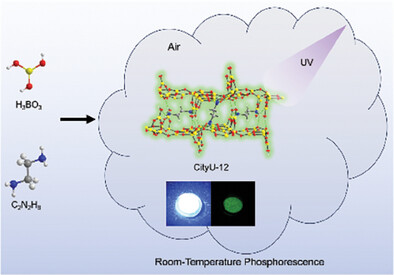
A 2D metal-free inorganic covalent framework ((H2en) [B5O8(OH)], named as CityU-12, and en represents for ethylenediamine) is successfully prepared. The structure is solved through single-crystal X-ray diffraction analysis. Optical measurement proves that CityU-12 exhibits excellent room-temperature phosphorescence (RTP) performance in air with emission peak at 530 nm, quantum yield of 84.6%, lifetime of ≈1.5 s, and afterglow time of 2.5 s.
Defect Passivation and Crystallization Regulation for Efficient and Stable Formamidinium Lead Iodide Solar Cells with Multifunctional Amidino Additive
- First Published: 01 July 2024

The different groups of amidino additives can largely impact defect passivation and crystallization dynamics of FAPbI3 perovskite. Compared with ABAc containing carboxyl group, ABAm with amide group at para-position of amidino possesses large dipole and enables stronger interactions with perovskite components to produce high-quality perovskite film, delivering the higher efficiency of 24.60% and better long-term stability in ambient condition.
Microcapsule Modification Strategy Empowering Separator Multifunctionality to Enhance Safety of Lithium-Metal Batteries
- First Published: 27 June 2024
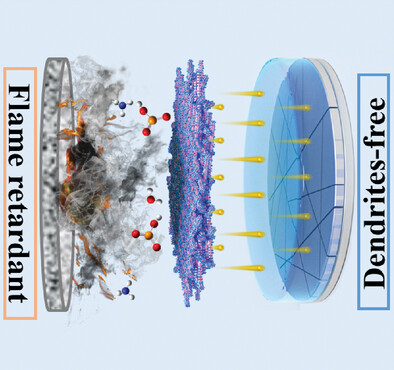
An advanced multifunctional separator with an extremely high electrolyte adsorption energy of surface silica microencapsulated ammonium polyphosphate particles anchored in an environmentally friendly polyvinyl alcohol fiber matrix is designed and constructed. The advanced separator demonstrates excellent electrochemical performances, lithium dendrite inhibition, and flame-retardant properties to drive the development of high-performance and high-safety lithium mental batteries.
Facile Synthesis of Organic–Inorganic Hybrid Heterojunctions of Glycolated Conjugated Polymer-TiO2−X for Efficient Photocatalytic Hydrogen Evolution
- First Published: 01 July 2024
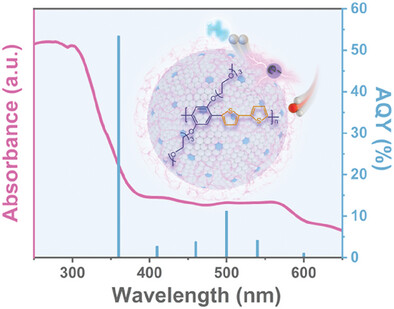
The hydrogen evolution rate of the stable organic–inorganic heterojunction PB2T-TEG-TiO2−X reaches up to 35.7 mmol h−1 g−1, with an apparent quantum efficiency as high as 53.32% at 365 nm. Furthermore, charge transfer pathways and catalytic mechanisms in these heterojunctions are scrutinized through femtosecond transient absorption spectroscopy and in situ XPS analysis.
A General Strategy toward Self-assembled Nanovaccine Based on Cationic Lentinan to Induce Potent Humoral and Cellular Immune Responses
- First Published: 28 June 2024
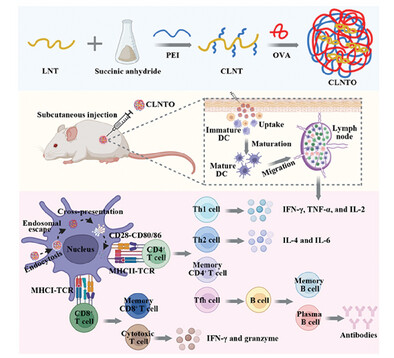
A self-assembled nanovaccine (CLNTO nanovaccine) is prepared by cationic Lentinan and ovalbumin. CLNTO nanovaccine induces the uptake and maturation of bone marrow dendritic cells via the TLR2/4 receptor to produce effective antigen cross-presentation. CLNTO nanovaccine has lymph node targeting and prolongs antigen release in the lymph nodes. Furthermore, CLNTO nanovaccine promote the interactions between T cells and B cells, and the generation of robust cellular and humoral immune responses.
Controlled Fabrication of Metallic MoO2 Nanosheets towards High-Performance p-Type 2D Transistors
- First Published: 11 July 2024
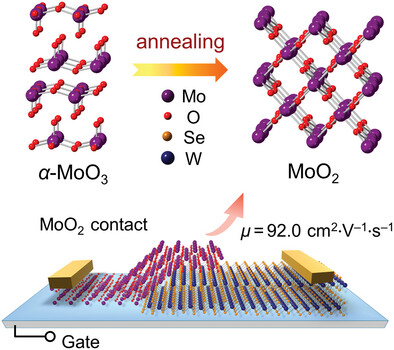
Through physical vapor deposition and postannealing, thin MoO3 nanosheets are completely converted into MoO2 with excellent crystal quality, which exhibits an exceptional electrical conductivity of 8.4 × 104 S m‒1. Using MoO2 nanosheets as the contact electrode for p-type WSe2 field-effect transistors can markedly enhance the transport property with a carrier mobility of up to 92.0 cm2 V‒1 s‒1.
Single Atom Ag Bonding Between PF3T Nanocluster and TiO2 Leads the Ultra-Stable Visible-Light-Driven Photocatalytic H2 Production
- First Published: 01 July 2024
An Ecofriendly Nature-Inspired Microcarrier for Enhancing Delivery, Stability, and Biocidal Efficacy of Phage-Based Biopesticides
- First Published: 28 June 2024
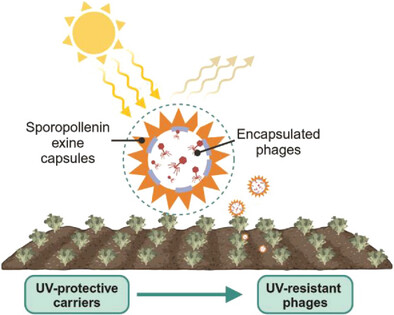
This study reports on a novel phage delivery system for enhancing the stability and biocidal efficacy of phages under field conditions. A rapid and non-thermal method is used to encapsulate phages into sporopollenin exine capsules (SECs) with high loading efficiency. This novel and scalable approach offers a promising strategy for the field application of phage-based biopesticides.
A High-Performance Passive Radiative Cooling Metafabric with Janus Wettability and Thermal Conduction
- First Published: 28 June 2024
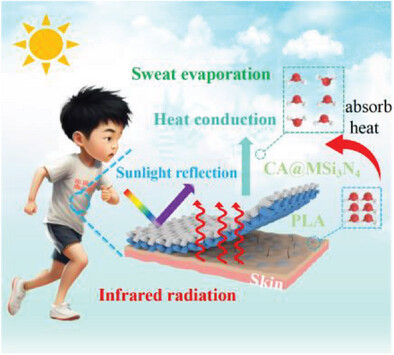
A hierarchical metafabric that integrates passive radiation, thermal conduction, sweat evaporation cooling, and excellent wearable comfort is designed and fabricated by an electrospinning strategy. The metafabric also exhibits desirable breathability, mechanical strength, and washability. The cost-effective and high-performance metafabric may provide a novel avenue for the development of next-generation personal cooling textiles.
Optimizing Integrated-Loss Capacities via Asymmetric Electronic Environments for Highly Efficient Electromagnetic Wave Absorption
- First Published: 02 July 2024
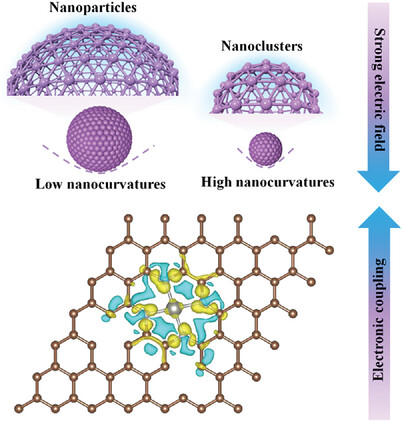
The authors have fabricated CoZn-MOFs derivatives with Zn SAs, structural defects, and small Co nanoclusters by a two-step dual coordination-pyrolysis strategy. Benefiting from the electronic coupling interactions between Zn SAs and structural defects, strong interfacial electric field induced by Co nanoclusters, and abundant crystal/amorphous heterointerfaces, the resultant derivatives deliver superior EM wave absorption.
Tailoring Mott−Schottky RuO2/MgFe-LDH Heterojunctions in Electrospun Microfibers: A Bifunctional Electrocatalyst for Water Electrolysis
- First Published: 06 July 2024
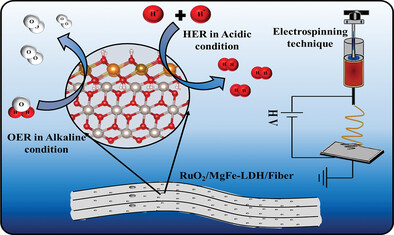
The RuO2/MgFe-LDH/Fiber material exhibits excellent electrocatalytic activity for oxygen evolution reaction in 1 m KOH and hydrogen evolution reaction in 0.5M H2SO4. The p-p junction boosts conductivity and active surface area for OER, while stacked RuO2 improves HER. The electrospun microfibre, requires only 273 mV (OER) and 122 mV (HER) overpotential at 10 mA cm−2, promising for water electrolysis and sustainable energy.
Enabling Quasi-Zero-Strain Behavior of Layered Oxide Cathodes via Multiple-cations Induced Order-to-Disorder Transition
- First Published: 28 June 2024
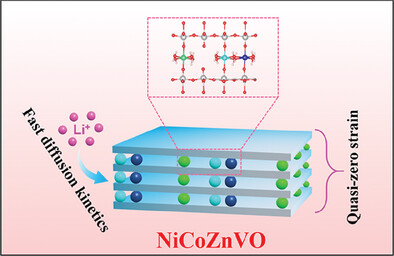
The cations/vacancy disordered structure not only increases the diffusion dimension of Li+, but also decreases the site energy of Li+ and constructs the fast track of Li+ diffusion. At the same time, the ternary cations pre-intercalation apply a prestress on the crystal face, which enables the structure to undergo a quasi-zero-strain process during the charging and discharging.
Fully Integrated and High-Throughput Microfluidic System for Multiplexed Point-Of-Care Testing
- First Published: 28 June 2024
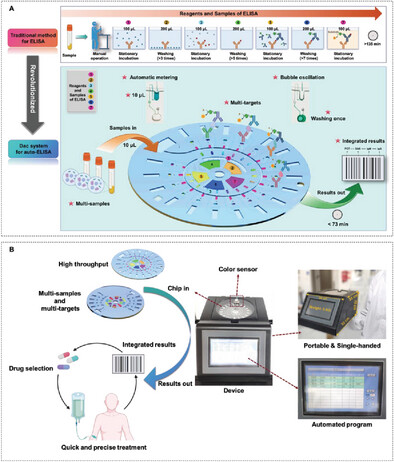
The Dac system can automate the on-demand sequential release of multiple solutions, high-throughput quantitative dispensing of released reagents, reproducible high-throughput independent metering, collection, mixing, and waste solution removal for multi-step repetitive mixing reactions on a single chip. More than 17 different immunoassays can be performed on a single chip, enabling high-throughput simultaneous analysis of 17 samples/targets.
Creation of Grooved Tissue Engineering Scaffolds from Architectured Multilayer Polymer Composites by a Tuneable One-Step Degradation Process
- First Published: 01 July 2024
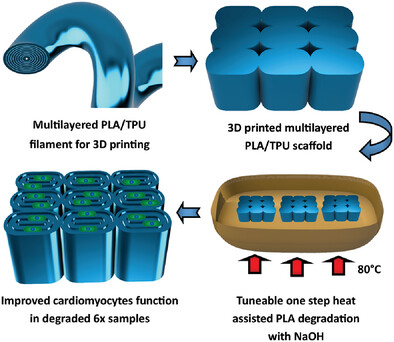
Multilayer polymer composite production and additive manufacturing with a controlled degradation process are combined in a facile process to generate polymer scaffolds with microscale topography. Neonatal rat cardiomyocytes (NRCMs) align with the grooves, achieving an elongated shape that promotes enhanced function. The material with the smallest groove width promotes synchronous beating of NRCMs after 3 days in culture.
Optimizing Droplet-Based Electricity Generator via a Low Sticky Hydrophobic Droplet-Impacted Surface
- First Published: 28 June 2024
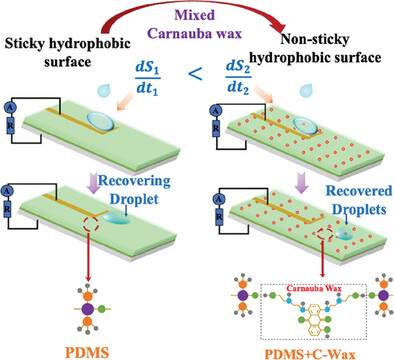
The integration of C-wax into PDMS surface creates microstructures, resulting in reduced adhesion between water molecules and the polymer surface. DEGs utilizing polydimethylsiloxane (PDMS) with carnauba wax (C-wax) show enhanced output due to decreased surface stickiness. This highlights that the synergy between surface hydrophobicity and stickiness in enhancing DEG efficiency.
Magnetic Tunability via Control of Crystallinity and Size in Polycrystalline Iron Oxide Nanoparticles
- First Published: 14 July 2024
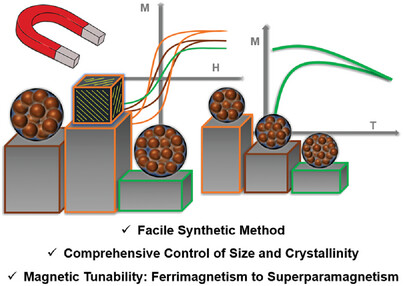
A facile synthetic approach for producing polycrystalline iron oxide nanoparticles with tunable size and crystallinity offers a viable tool for achieving magnetic tunability from ferrimagnetic to superparamagnetic properties. This method provides opportunities for exploring the nano-magnetism of nanoparticles and developing applications across various fields that utilize magnetic nanoparticles with desired magnetic properties.
Amphiphilic Nanoscale Antifog Coatings: Improved Chemical Robustness by Continuous Assembly of Polymers
- First Published: 11 July 2024
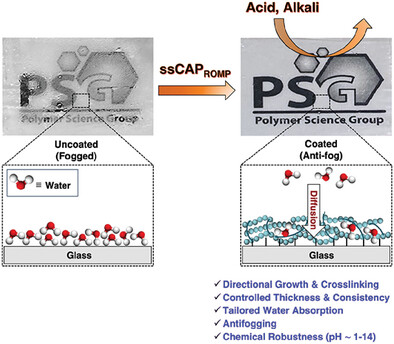
Surface-confined/cross–linked thin films (≤100 nm), precisely controlled in thickness, consistency, and water absorption, are engineered via solid-state continuous assembly of polymers (ssCAP). These nano-engineered films exhibit antifogging properties owing to their zwitter-wettability, with enhanced stability even under chemically aggressive conditions due to their robust surface chemistries, rather than just amphiphilic structure.
Dual-Drug Nanomedicine Assembly with Synergistic Anti-Aneurysmal Effects via Inflammation Suppression and Extracellular Matrix Stabilization
- First Published: 02 July 2024
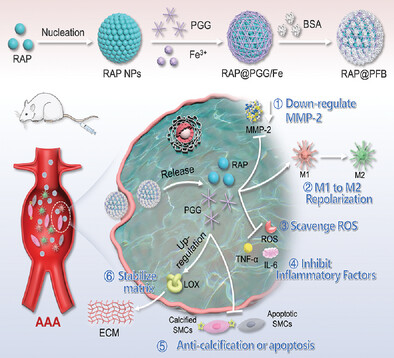
This study investigates the potential of an innovative dual-nanodrug delivery system, termed RAP@PFB, which exhibits rapid accumulation at abdominal aortic aneurysm sites post intravenous administration, maintains prolonged retention, and releases drugs in response to the abdominal aortic aneurysm microenvironment stimulus. The combined effects of PGG and RAP demonstrate robust efficacy in attenuating AAA progression through multiple mechanisms.
K-Doping Suppresses Oxygen Redox in P2-Na0.67Ni0.11Cu0.22Mn0.67O2 Cathode Materials for Sodium-Ion Batteries
- First Published: 03 July 2024

Na site-regulation in a P2-type layered oxide cathodes is applied to modulate the Na+ distribution and structural stability. Density functional theory calculations suggest a remarkable suppression of oxygen redox reaction upon K+ incorporation, a finding further validated experimentally by resonant inelastic X-ray scattering spectroscopy.
An Active Strategy to Reduce Residual Alkali for High-Performance Layered Oxide Cathode Materials of Sodium-Ion Batteries
- First Published: 03 July 2024
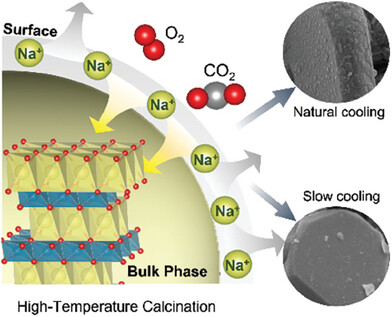
An active strategy is introduced to reduce residual alkali by slowing the cooling rate, which notably enhances the internal uniformity and facilitates the reintegration of Na+ into the bulk material, thus substantially reducing surface impurities. This strategy can remarkably suppress the slurry gelation and gas evolution while enhancing structural stability.
Scott–Russel Linkage-Based Triboelectric Self-Powered Sensor for Contact Material-Independent Force Sensing and Tactile Recognition
- First Published: 03 July 2024
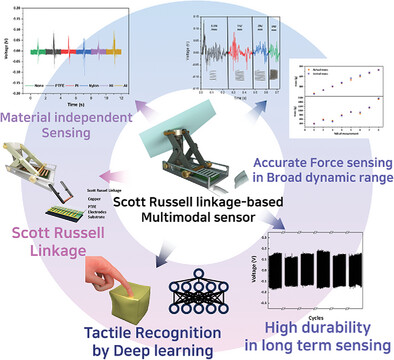
IoT is growing rapidly through the convergence of artificial intelligence, and force sensors are essential for 3D space applications. Conventional TENG-based force sensors suffer accuracy issues depending on contact materials. By introducing the Scott–Russell linkage, SRI-TENG separates signal generation and measurement, improving accuracy. Lubricant enhances durability, enabling stable measurements for 270 000 cycles. Also, utilizing deep learning SRI-TENG can recognize tactile properties.
Stretchable Tissue-Like Gold Nanowire Composites with Long-Term Stability for Neural Interfaces
- First Published: 30 June 2024
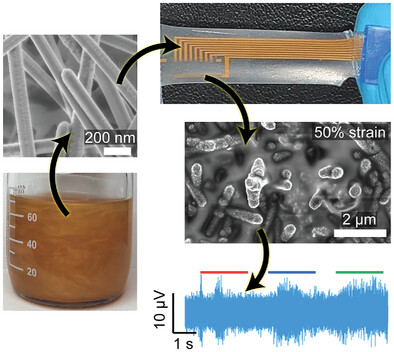
High aspect ratio gold nanowires (AuNWs) of controlled dimensions are synthesized using silver nanowire templates. AuNW-soft silicone rubber composites demonstrate outstanding electrical conductivity in combination with tissue-like mechanical properties. Conformal neural electrodes based on the composite can selectively stimulate and record tactile induced response in peripheral nerves and show an accelerated lifetime stability of >3 years.
MXene-Derived TiO2/Starbon Nanocomposite as a Remarkable Electrode Material for Coin-Cell Symmetric Supercapacitor
- First Published: 04 July 2024
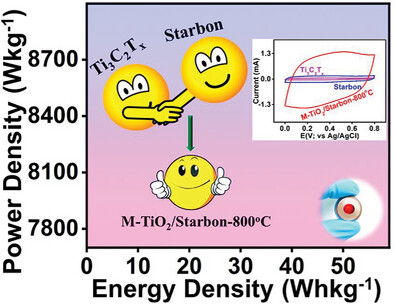
The calcination process transforms MXene and starbon, forming M-TiO2/Starbon-800 °C nanocomposite where MXene converts into rod-like TiO2 and starbon into amorphous carbon. This nanocomposite exhibits a specific capacitance of 115 Fg⁻¹ at 1 Ag⁻¹ in the coin cell supercapacitor configuration. At 5 Ag⁻¹, the device achieves an energy density of 51 Whkg⁻¹ and a power density of 7912 Wkg⁻¹, demonstrating robust cycle life.
Vacancies-Induced Delocalized States Cobalt Phosphide for Binder-Free Anode Toward Stable and High-Rate Sodium-Ion Batteries
- First Published: 07 July 2024
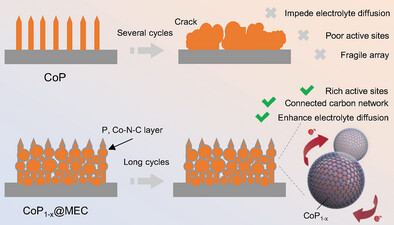
In situ coating of the Co─N─C protective layer and introduction of P vacancies on CoP can expose vast active interfaces, and provide a large number of electrolyte penetration channels and highly conductive ion/electron transport networks, resulting in efficient storage of Na+ and fast electrode kinetics.
Solar-Powered Gram-Scale Ammonia Production from Nitrate
- First Published: 02 July 2024
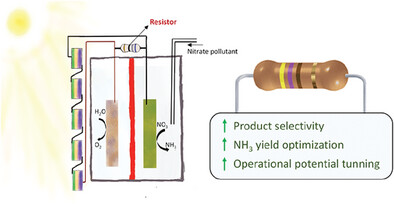
Nitrate pollution is a global issue, converting it to ammonia-fertilizer via nitrate reduction with renewable energy is attractive. This study explores how voltage and external resistance affect product selectivity in NiCo-layered double hydroxides (LDH)-based nitrate reduction reactions, paving the way for precise control and efficient conversion.
Homogenizing The Low-Dimensional Phases for Stable 2D-3D Tin Perovskite Solar Cells
- First Published: 06 July 2024
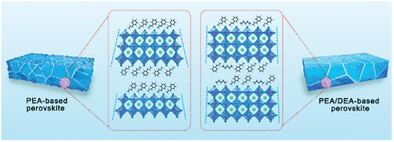
Mixed spacer cations [diethylamine (DEA+) and phenethylamine (PEA+)] favor the formation of homogeneous low-dimensional tin perovskite phases with three octahedral monolayers (n = 3), especially near the bottom interface between perovskite and hole transport layer. The homogenization of 2D phases helps improve the film quality with reduced lattice distortion and released strain.
Ultra-Small High-Entropy Alloy as Multi-Functional Catalyst for Ammonia Based Fuel Cells
- First Published: 02 July 2024
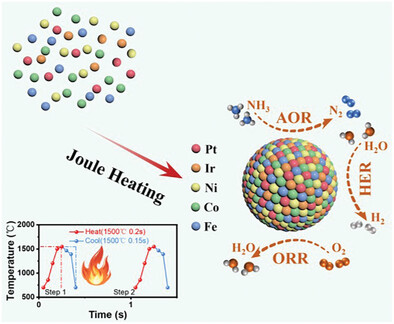
PtFeCoNiIr/C high-entropy alloy electrocatalysts with ultra-small size of 2 nm are synthesized on carbon black with abundant specific surface area in 0.35 s by rapid Joule heating. PtFeCoNiIr/C exhibits excellent electrocatalytic performance for AOR, ORR, and HER. In addition, the excellent anti-neutralization toxicity establishes a promising application in practical ammonia fuel cells.
Rational Design Strategy for High-Valence Metal-Driven Electronically Modulated High-Entropy Co–Ni–Fe–Cu–Mo (Oxy)Hydroxide as Superior Multifunctional Electrocatalysts
- First Published: 01 July 2024
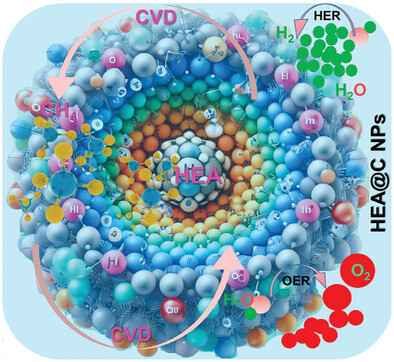
An innovative approach to developing high-entropy Co–Ni–Fe–Cu–Mo (oxy)hydroxide electrocatalysts for OER is presented. By incorporating the high-entropy (HE) concept into cobalt-based (oxy)hydroxides, DFT is used to analyze the electrocatalytic performance of Co, Ni, Fe, and Mo doped Cu (oxy)hydroxides. This analysis includes the examination of reaction models, energy barriers, and adsorption geometries. These electrocatalysts are synthesized using low-temperature CVD method.
A Strategy to Mitigate Jahn Teller Effect of Mn-Rich NASICON Framework for Sodium-Ion Batteries
- First Published: 18 August 2024
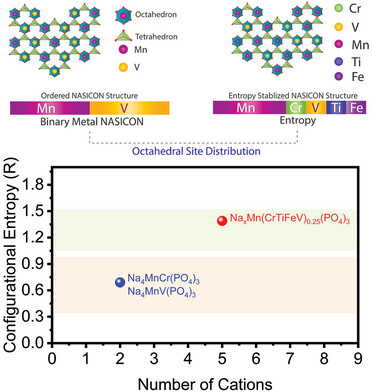
Mn-based NASICON has attracted tremendous attention as a cathode material for sodium-ion batteries. Herein, sodium-deficient entropy stabilized Mn-rich NASICON is synthesized to mitigate the Jahn-Teller effect for high rate and long cyclic performance. This study has great significance in exploring advanced Mn-based low-cost cathode materials for SIBs.
Creating CoRu Dual Active Sites Codecorated Stable Porous Ceria Support for Enhanced Li–CO2 Batteries Cathodes
- First Published: 28 June 2024
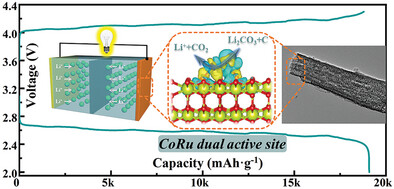
The robust synergistic effect of the catalytically active substances based on CoRu bimetallic active sites results in a notable enhancement of the electrochemical activity as well as the electrochemical stability of the carriers, and the CoRu-CeO2 based Li–CO2 achieved excellent discharge performance, cycling performance, and low overpotential.
Oxygen-Terminated Polycrystalline Boron-Doped Diamond Superhydrophobic Surface with Excellent Mechanical and Thermal Stabilities
- First Published: 02 July 2024
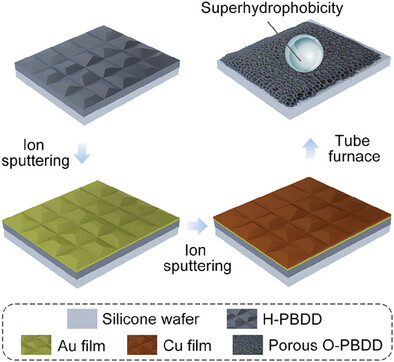
This research introduces an oxygen-terminated polycrystalline boron-doped diamond (O-PBDD) superhydrophobic surface. In the preparation, hydrogen-terminated polycrystalline boron-doped diamond (H-PBDD) acted as a starting material. The O-PBDD surface can maintain satisfactory superhydrophobicity even after high-pressure, high-temperature, and sandpaper friction tests. This work may provide a new research direction for fabricating robust superhydrophobic materials with diamond film.
Microfluidic Continuous Synthesis of Size- and Facet-Controlled Porous Bi2O3 Nanospheres for Efficient CO2 to Formate Catalysis
- First Published: 01 July 2024
An Impressive Open-Circuit Voltage of 1.223 V and High Humidity Stability of Perovskite Solar Cells with MgO Buffer Layer Deposited by Low-Temperature Atomic Layer Deposition
- First Published: 01 July 2024
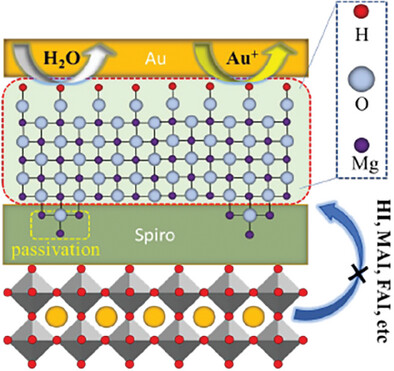
The poor stability of perovskite solar cells is still a fatal defect. MgO buffer layer prepared by LTALD resists the erosion of water vapor, inhibits the migration of metal ions and the decomposition products of perovskite, and finally improves the stability of the device. At the same time, it passivates the defects of Spiro, thus enhancing carrier transport efficiency and device performance.
Lanternarene-Based Self-Sorting Double-Network Hydrogels for Flexible Strain Sensors
- First Published: 29 June 2024

A conductive and tough double network hydrogel is fabricated via a self-sorting process with cationic polyacrylamide and lantern[33]arene. The stretchability of this hydrogel is greatly improved after the kirigami cutting, which made the hydrogel can be used as flexible strain sensor for monitoring human motions, like bending of fingers, wrist, and elbows.




